- Privacy Policy

- Houseplants
- Gardening And Landscaping

Wandering Jew Plant (Tradescantia or Spiderwort): Care, Types, Images and More
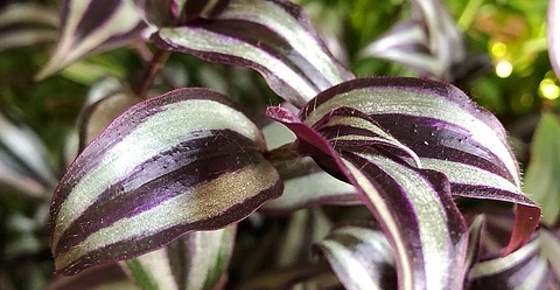
The wandering Jew plant is a common name for different species of plants that belong to the Tradescantia genus. There are around 75 different types of plants in Tradescantia genus and some are called inch plants, spiderwort, striped wandering Jew, Boat Lily, Purple Queen, or flowering inch plant. Wandering Jew plants are great house plants because they are relatively easy to care for. They are also easy to grow because the wandering Jew plant propagates easily from cuttings.
Some types of wandering Jew plants have green and gold leaves, some have reddish leaves, and others have green fuzzy leaves. There are also types of wandering Jew plants that flower. Depending on the species, the wandering Jew plant could have purple, white, or pink flowers.
How to care for wandering Jew plant : For the Tradescantia or spiderwort plant to thrive, grow in a plenty of indirect light and plant in fertile, moist potting soil with good drainage. Make sure the soil isn’t too dry or too damp and keep medium humidity levels. The ideal temperature range is between 65°F (18°C) and 75°F (23°C). You can fertilize every four weeks during the growing season with a diluted liquid houseplant fertilizer.
In this article, you will find all you need to know about this delightful houseplant. You will also get tips and ideas on how to care for your wandering Jew plants.
Wandering Jew Plant (Tradescantia or Spiderwort) – Overview of the Plant and Its Flowers
The botanical name for wandering Jew plant is Tradescantia zebrina and is also called the inch plant. However, the name wandering Jew is given to many herbaceous perennial plants in the Tradescantia genus. ( 1 )
Species of Tradescantias naturally grow outdoors in countries in Asia, Africa, Central and South America, and Australia. Varieties of wandering Jew plants also thrive well indoors, where, like their garden varieties, they grow well when it is warm, sunny, and moderately humid.
According to the United States Department of Agriculture, various varieties of Tradescantias are regarded as invasive plants in the wild. However, it is the fast-growing nature of spiderworts, wandering Jews, and inch plants that makes them perfect houseplants. ( 2 )
Many people like to grow wandering Jews or spiderworts in hanging baskets or grow them in pots to decorate a garden.
What does a wandering Jew look like?
Plants from the Tradescantia varieties have leaves that seem to grow in all directions (hence the term “wandering Jew”).
One of the distinct features about foliage on wandering Jews is that many of them have striped leaves. Sometimes, the leaves can be purple and silver stripes, whereas other types of Tradescantias have leaves that are almost all silver. ( 3 )
You may also notice that some varieties of wandering Jew plant have different colors on the underneath of the leaf. For example, the Tradescantia zebrina has green/silver leaves on the upper side and deep red or burgundy colors on the underside.
Wandering Jew flower
Wandering Jew houseplants also produce attractive flowers. These flowers can sometimes be white or can range in color from pink to various shades of lilac and purple. ( 3 )
However, plant lovers don’t usually grow wandering Jews indoors or outdoors for their blooms. It’s the beautiful variation of leaf colors that makes various types of Tradescantias so desirable houseplants.
Types of Wandering Jew (Spiderwort) Plants
The most popular types of Tradescantia plants to keep indoors are Tradescantia fluminensis ( spiderwort ), Tradescantia pallida ( purple heart ), and Tradescantia zebrina ( wandering Jew ).
Wandering Jew or inch plant ( Tradescantia zebrina )
This type of wandering Jew houseplant has purple and green leaves with a stripe pattern that resembles zebra’s stripes. There are types of wandering Jews that have bluish green leaves and purple hues on the underside.
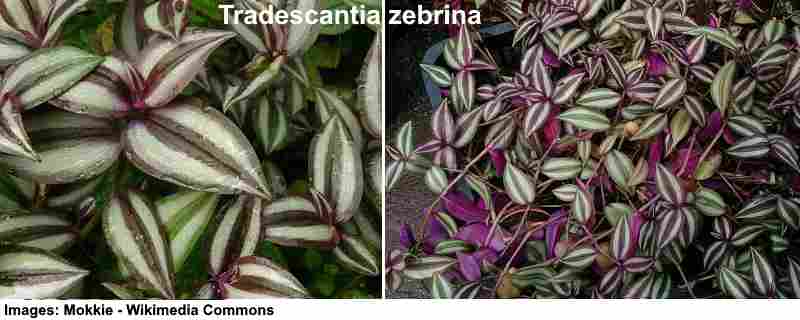
Tradescantia fluminensis (spiderwort)
There are a number of types of Tradescantia that are called spiderwort. This is distinguished from some Tradescantias as it has ovel shiny dark green leaves with pointed tips which are slightly fleshy .
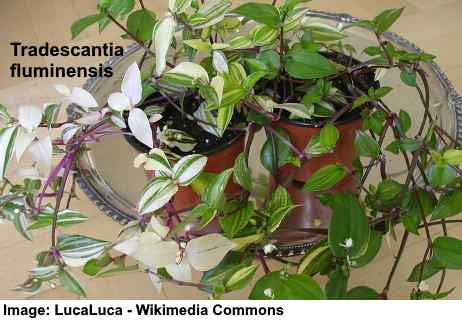
Picture of wandering Jew plant with white flowers
Tradescantia pallida (purple heart)
This type of spiderwort plant is also commonly referred to as wandering Jew. The T. pallida houseplants have vibrant purple leaves and light pink flowers when they bloom.
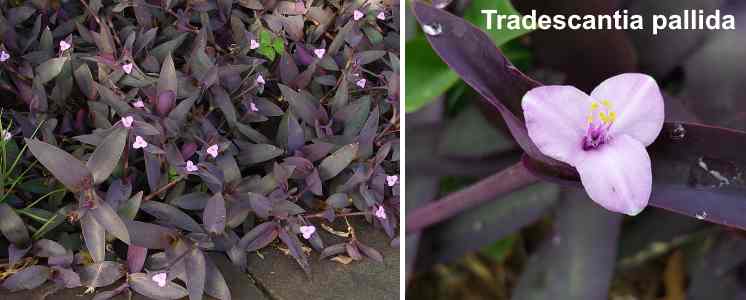
Wandering jew plant with deep purple leaves and light purplish-pink flowers
Tradescantia callisia
The leaves of T. callisia varieties are sometimes referred to as creeping inch plants. They have remarkably stripy leaves made up of green and white stripes.
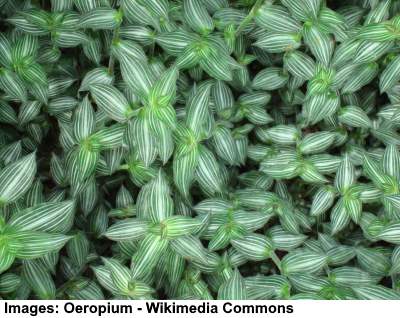
Picture of green wandering jew
Wandering Jew Plant Care (How to Grow Spiderwort or Tradescantia)
Caring for wandering Jew plants is fairly simple and straightforward. All plants in the Tradescantia genus enjoy moist soil, sunny but indirect sunlight, and warm conditions.
So, it doesn’t matter if you have fuzzy leaf Tradescantias, purple queen varieties, spiderworts, or wandering Jews, they all require the same type of care.
Light requirements for Tradescantias
To make sure that wandering Jew plants grow successfully, they require a good amount of light. This ensures that they grow with healthy leaves that have a vibrant green, silver, purple, or lilac colors.
The best place to place wandering Jew plant or spiderworts is in an east- or west-facing location. This means that they get plenty of natural light without being in direct sunlight when the sun is at its strongest.
The only exception is if you have Tradescantia pallida plants with dark purples leaves. They usually thrive in direct sunlight, although you should regularly check them in the summertime to make sure the sun isn’t too strong.
One sign that your Tradescantia isn’t getting enough light is if the color of their leaves starts to fade.
Best growing temperature for Spiderwort or Tradescantia
One of the reasons why wandering Jew plants are good for the home is that they thrive in room temperature.
The best temperatures for growing any type of Tradescantia plant is between 65°F (18°C) and 75°F (23°C). The houseplants also thrive in conditions that are described as “average humidity.”
If you grow Tradescantias outdoors, you should be aware of a drop in night temperatures and lower temperatures during winter. You should bring Tradescantias indoors if the temperature drops.
Best watering techniques for wandering Jew plant care
To care for your inch plant, spiderwort, or wandering Jew, you should keep the soil moist.
The best way to water a wandering Jew is to water the soil thoroughly and let the water drain out the bottom. Another way to water your purple house plant is to put water in the plant pot tray and allow the plant to soak up as much as it needs.
Some beginners who start caring for houseplants such as Tradescantias for the first time buy a soil moisture gauge to help get the soil moisture levels just right.
When it comes to proper watering for your wandering Jew, always make sure the soil isn’t too dry or too damp. Usually, weekly watering in the summertime is enough to keep your Tradescantia growing well.
The best fertilizer for wandering Jew houseplants
The reason why Tradescantias are so easy to care for is that they don’t usually require any feeding.
If you decide to encourage your inch plant or spiderwort to grow faster, then choose a liquid organic fertilizer mixed at half strength and use once a month.
Most houseplant growers don’t feed their wandering Jew plants in the fall or winter as they tend to become “leggy” or “straggly.”
Which type of soil to use for Tradescantias
To properly care for wandering Jew varieties of houseplants, you only need to plant them in regular potting soil.
How to prune wandering Jew plants
In time, Tradescantia plants require some cutting back and pruning. This helps to give your houseplant a bushier appearance and also gives you plenty of cuttings to propagate.
For Tradescantia pruning, you just need to pinch off the stem tips to leave about ¾ of the length. This will encourage your plant to grow better and become more attractive.
Growing Plants from Wandering Jew Cuttings
Even for the most novice of houseplant owners, propagating any type of Tradescantia plant is very easy. After you have cut back your “leggy” wandering Jew stems, you will have a large number of cuttings that you can use to grow new house plants.
How to propagate wandering Jew plant leaves
To prepare your wandering Jew cuttings or purple heart plant cuttings for propagation, you need a couple of stems about 1-2 inches long. Remove all the leaves apart from 2 or 3 at the end of the stem.
There are 2 ways you can grow wandering Jew plants from cutting:
- The first way is to just put a cutting in potting soil and wait for it to grow. All you have to do is make sure that the soil is kept moist and not overly damp.
- The other way to grow a Tradescantia from a cutting is to put the stem in water. You should notice that new roots start to grow within a week. When you notice new roots growing, you can transfer your cuttings to a pot to grow a new houseplant.
Wandering Jew Outdoor Plant Care
Tradescantia plants are great garden plants and grow well outdoors in warmer zones in the U.S. (USDA growing zones 9-11). In fact, it is because they grow so well outside in warmer countries and are quite invasive that they are classed as a weed in certain countries.
You can easily care for any Tradescantia plants to add color and beauty to your garden. Purple hanging plants or wandering Jew vines with stripy leaves can grace any patio, doorway, or garden area.
As with caring for wandering Jews or spiderworts indoors, Tradescantia plants growing outdoor should be protected from direct sunlight. So, place your plants in shady areas of the garden. But it’s good to remember that some bright light will help the wandering Jew plant produce more flowers.
Temperature
Also, frost can damage the plant, so, if you live in areas where fall and winter temperatures drop below 10°F (12°C), you should take them indoor and continue to grow them as houseplants.
Problems with Wandering Jew Plant (Spiderwort)
Even though it is relatively easy to care for wandering Jew plants, you can still come across certain problems.
Let’s look at some growing tips for Tradescantia plants to avoid or remedy some common problems.
The most common pest when growing wandering Jews indoors are bugs such as spider mites or aphids . The appearance of these pests on your bushy spiderwort or inch plant may be a sign that conditions are too dry.
To help remedy the problems of pests on your Tradescantia, mist the leaves regularly and make sure the soil is moist enough. You may need to wash off the mites with water to help get rid of the infestation.
One of the beauties about caring for wandering Jew plants indoors or outdoors is that they are not susceptible to disease. Usually, any discoloration of the leaves or poor growth is connected to the soil being too dry or too damp.
Fungal infections
Overwatering spiderworts, inch plants, or wandering Jews can cause a fungal growth called botrytis to develop in the roots.
Brown leaves
As with most problems associated with caring for Tradescantias, brown leaves can also indicate that the growing environment isn’t right. The leaves of your wandering Jew could have turned brown because of too much or too little sunlight. Also, too much watering can affect leaf health.
Where to Buy Wandering Jew Plants
Many garden centers and online stores stock many different varieties of wandering Jews. You will also find that Tradescantia cuttings are available online.
Because many different types of wandering Jews are so easy to grow yourself, you could ask a friend for a cutting if they have the plant. You can also get more Tradescantia houseplant or garden plants by propagating cuttings from plants you already have.
FAQ Related to Wandering Jew Plant (Tradescantia)
Do they need any pruning.
To properly care for wandering Jews, the leaves and stems require pruning. The stems can grow quite long and start losing their leaves from the base. The best time to prune any Tradescantia plant is just before the growing season in late winter or early spring.
You may also find that Tradescantias grow better if you give them a mild prune in late summer.
How to prevent wandering Jew roots from rotting?
Go easy on the watering to stop Tradescantia plants’ roots from rotting. Water them enough to keep the soil moist during summertime and only occasionally in the winter.
Are wandering Jew plant leaves toxic to animals?
While not toxic to cats or dogs, the leaves of wandering Jew plants can cause irritation. If you have pets that like to nibble on leaves, you can still benefit from the beauty of Tradescantias if you grow the outdoor plant in hanging baskets.
Can I grow my Tradescantia plant outdoors?
Yes, you certainly can. Wandering Jew plants grow well out of doors in warm climates. During the summertime, you can move your indoor houseplants to the garden and place them away from direct sunlight.
Dashes of purple colors, bright pinks, or interesting green and purple stripped leaves can make an interesting feature in any garden or balcony.
Can you train a wandering Jew plant?
Tradescantia plants are easy to train because their stems can grow very long and you can wrap them around objects. Wandering Jew plant stems can grow up on trellises or obelisks or up around any other item.
Heavily pruning wandering Jews in late winter can also help to train the plant to grow into a colorful bush.
How fast does wandering Jew plant grow?
Tradescantia cuttings should start growing roots within a week or so. Once the plant is established, you can expect it to grow about an inch every week. Some people claim this is the reason that some Tradescantias are called inch plants.
Can Tradescantia houseplants cause allergies?
The sap of wandering Jew plants or prolonged skin exposure to its leaves could cause allergic reactions.
The journal Allergy reports that indoor plants such as Tradescantia can also cause symptoms such as itching of the throat, swelling, wheezing, and runny eyes and nose. ( 4 )
Do wandering Jew varieties have any health benefits?
Although not widely used, extracts from Tradescantia zebrina have certain medicinal properties. You can buy inch plant herbal liquid extracts that are said to have many antioxidant properties.
Researchers have found that therapeutic compounds in Tradescantia extracts have antibacterial, anticancer, and antioxidant uses. ( 5 )
Related articles:
- Moses In Cradle Care: How to Grow Tradescantia spathacea
- Chinese Money Plant Care: How to Grow Pilea Peperomioides
- Dracaena Marginata Plant Care: How to Grow Madagascar Dragon Tree

- Indoor Gardening
- Houseplants
- Hydroponics
- Houseplants Made Easy Book

How To Care For A Wandering Jew Plant (Your Complete Guide)
When it comes to houseplants able to brighten up indoor spaces, it doesn’t get much more colorful than the variegated foliage of a Wandering Jew plant ( Tradescantia zebrina ). With their hardy nature and ease of care, they are a perfect choice for those feeling they kill everything they bring indoors. We’ve listed a quick summary of their care below.
How To Care For A Wandering Jew Plant: Grow your Wandering Jew in well-drained soil, kept moist but not soggy through regular watering. Create humidity, keep indoor temperatures between 50°F (10°C) to 85°F (29°C) and fertilize monthly.
Continue reading because we’ve taken all the guesswork out of caring for your Wandering Jew and keeping it healthy and happy for years to come.
How To Care For A Wandering Jew Plant
Wandering Jew plants belong in the Commelinaceae family, which includes around 652 different species. The family is made up of herbs, climbers and several epiphytes, with some used as outdoor and indoor ornamentals like Wandering Jew.
There are three different plants commonly known as Wandering Jews; Tradescantia fluminensis , Tradescantia pallida , and Tradescantia zebrina. Of the three, Tradescantia zebrina is the most common one grown and has the most eye-catching and colorful foliage. All three have the same requirements for care and good growth.
Native to Mexico and Guatemala, Wandering Jew is classified as a tender evergreen perennial that performs well planted outdoors in frost-free regions. Those living in cooler environments can easily grow it as an indoor plant planted either in containers or in hanging baskets. Outdoors it’s typically used as a quick-growing groundcover.
Although a common name shared with several very different plants, Wandering Jew is often called Inch Plant , due to the leaf margins being spaced about an inch apart. You may also find Wandering Jew listed as Zebrina Pendula , but is synonymous with Tradescantia zebrina and is the same plant.

When it comes to Wandering Jew plants, it’s all about the attention-grabbing foliage. The succulent stems give way to leaves that are a deep purple on their undersides with the upper portion striped in silvery-gray and greenish-blue. The oval leaves grow to about 2.5 inches long and the stems grow about 2 feet long. It makes a beautiful plant used in hanging baskets, with the long stems cascading over the side.
Even grown indoors, Wandering Jews have a fast rate of growth and before you know it, the plants will be spilling over your container’s or hanging basket’s sides. Whereas some indoor plants seem to take forever to fill out, this isn’t a problem with properly cared for Wandering Jew plants.
There are several other cultivars (varieties) of Wandering Jew, which include:
- ‘Purpusii’ has unstriped, hairy foliage that is either solid red or reddish-green.
- ‘Quadricolor’ produces metallic-green foliage striped in red, white and green.
Wandering Jew plants are the ideal candidates for beginner houseplant gardeners due to their hardiness and robust growth. Below we’ve outlined all the basics of their proper care, as well as identifying and preventing any potential problems so you can enjoy your Wandering Jew for years to come. The best indoor plants are those that are happy and healthy.

Soil Conditions For Wandering Jew Plants
Wandering Jew plants tolerate growing in a wide range of soils provided they drain well. Although they do tolerate and prefer moist conditions, the soil must drain properly to prevent root and stem rot from occurring. Therefore, it is necessary to use a lighter weight soil mixture in your pots rather than heavier soils that don’t provide proper drainage.
Straight potting soils are usually too heavy, retain too much moisture and have a tendency to leave the soil soggy. You can use a heavier potting soil in your soil mixture, just be sure to incorporate a lighter soil mix to provide the Wandering Jew the drainage required for healthy growth.
Commercial potting mixes work well and many have a slow-release fertilizer mixed in, which cuts down on the need for frequent feedings. The slow-release blends usually continue to fertilize the Wandering Jew for about three months.
You can also make your own soil by mixing several ingredients together such as:
- Using equal parts of compost and a potting mix.
- Mixing equal portions of compost, peat and potting soil or a potting mix.
- Using equal portions of a course sand, compost and potting soil or a potting mix.
Whatever soil you choose to use, just make sure it drains well and contains a bit of fertility for the best performance of your Wandering Jew plants.
Preferred Light Conditions
Although Wandering Jew plants tolerate lower light conditions than many houseplants, to help retain those striking colors the plant is known for, place the container in a location indoors receiving filtered sunlight. If your plant starts losing some of the color in the foliage, move it to a location that receives a bit more light.
In addition, if the lower portion of the stems start suffering leaf drop, the Wandering Jew isn’t get enough light and needs to be relocated to a brighter area inside the home.
Once the warm weather of spring arrives and if you’d like to give your Wandering Jew a bit of a break from its indoor location, place it in an outdoor spot that receives partial sun to partial shade. Moving it to an outdoor location with too much sun may leave the foliage sunburned.
Indoor Temperature Requirements
In the Wandering Jew’s native environment, temperatures are consistently warm without the threat of frosts or freezes. Generally, if the indoor temperatures inside your home are comfortable for you, they will also be comfortable for your Wandering Jew plant.
Indoor temperatures between 50°F (10°C) to 85°F (29°C) are a good range for your Wandering Jew plants. Plants grown in this temperature range produce the healthiest growth.
If you gave your plants a break from their indoor location, just make sure to bring them back indoors before the cold weather of winter strikes.
Water Requirements
Wandering Jews prefer soils that are regularly kept moist, not soggy, compared to many indoor houseplants. However, this doesn’t mean the soil should be kept so wet they never begin to dry out. Keeping the soil too wet for too long promotes rot to set in and you may end up killing your Wandering Jew plants. Your Wandering Jew is more likely to forgive you if you forget to water over watering too much and too often.
A good rule to follow is if the soil starts to feel like it’s about to become very dry, apply water. It’s easy to know exactly when to water by:
- Sticking your finger into the soil and if the top inch is starting to feel dry, water until it runs from the container’s bottom drain holes.
During the warm growing season of spring through summer, you can probably expect to water once each week. However, during winter when the Wandering Jew goes into dormancy (its growth slows), you will probably only need to water about every other week.

Humidity Requirements
Compared to many tropical plants grown indoors, Wandering Jew plants aren’t quite as fussy about humid conditions , but still need some humidity for the best growth and performance. Don’t let the thought of creating a humid environment stress you out because replicating humidity for your indoor plants is relatively easy and basic.
- Fill a spray bottle with room temperature water and mist the Wandering Jew several times each week.
- If you’re growing the Wandering Jew in a container and not in a hanging basket, you can set the pot on a tray of pebbles. As you water, the water seeps from the bottom drain holes onto the tray of pebbles and as it evaporates, it creates a humid environment around the plant.
- If your bathroom gets the appropriate amount of light for the Wandering Jew, you can allow it to grow there. Due to the regular use of water in a bathroom, moisture is created, creating the humidity the Wandering Jew requires.
Fertilizer Needs
Unless the soil mixture contains a slow-release fertilizer blend, which feeds the Wandering Jew for about three months, fertilizing monthly is sufficient for proper growth. You have several choices when it comes to fertilizer you can use for your Wandering Jew plant.
- Use a houseplant fertilizer applied at half-strength, applied when you do your regular watering.
- Use an all-purpose, water-soluble blend for outdoor and indoor plants, applied at half-strength and used during your regular watering schedule.
- If your soil mixture didn’t contain a slow-release fertilizer or it’s been about three months, if one was contained in the soil, you can reapply slow-release fertilizer granules sprinkled over the top of the soil. Follow the package directions on amounts.
When it comes to the appropriate time of year to fertilize the Wandering Jew, only fertilize while it’s actively growing, which is spring throughout summer. In winter, the plant goes through a dormant stage and all growth slows, so there is no need to apply fertilizer. Wait until spring arrives before you resume fertilizing the plant.
The one thing you will need to pay attention to when it comes to fertilizing is the buildup of salts in the soil, which can result in foliage burns. Wandering Jew plants have a low tolerance to salty soils. Preventing any salt buildup is relatively simple:
- If the plant isn’t too big, you can take the entire pot to your sink or bathtub and allow water to run slowly through the soil for about five minutes, flushing out any salts.
- If the plant is too big for indoor flushing, take it outside and allow water from the hose to run slowly through the soil for about five minutes. Allow the water to drain and then bring the plant back indoors.
Pruning Requirements
The pruning needs of Wandering Jew plants are low. If you want to control the size of the plant and promote bushier growth, you can pinch off the tips of the stems. To keep the plant always looking its best, you can trim off any broken, dead or damaged stems and leaves throughout the year.
When using pruning tools to trim your Wandering Jew always make sure they are clean so you don’t transfer any diseases or pests to your plant. This is as easy as wiping off the blades with alcohol.
Some people experience skin irritations when handling the cuttings due to the sap , so if you are unsure if you are one of these unlucky gardeners, it might be best to wear gardening gloves when pruning or handling Wandering Jew cuttings.
Potting Needs
If you purchased your Wandering Jew already potted in a hanging basket or 1-gallon container, it should thrive as is for a year or more before it requires repotting. However, if you received rooted cuttings in smaller containers like 4- to 6-inch pots, you most likely need to repot them into something a bit larger so they can grow properly.
This also cuts down on the need for repotting in a month or two as the Wandering Jew begins to outgrow its present pot.
When it comes to the pot’s material, any type works quite well for growing this plant from clay to plastic. However, if you grow your Wandering Jew in a pot made of a porous material like terra cotta, the soil is going to dry quicker than if it was growing in a plastic pot. This means you will need to water more frequently.
Once your Wandering Jew starts getting too big for its present container, it’s time to repot it into one that is around 1- to 2-inches larger. Although the plant likes a moist soil, make sure the pot has bottom drainage to prevent the possibility of rot due to conditions that are too wet.
If you like, you can dress the container up by placing the draining one inside a decorative pot without bottom drain holes, but be sure to empty out any additional water once the inner pot thoroughly drains.
I think a decorative outer pot can add so much to the beauty of your houseplants, so I do this with almost all of my houseplants. Read this article which discusses my favorite decorative planters if you need some inspiration.
Potting and repotting your Wandering Jew is basic:
- Gently remove the Wandering Jew from its present container, being careful not to break the succulent stems.
- Fill the new container that drains about a quarter of the way full with a fertile, well-drained potting mix.
- Check the Wandering Jew’s root system and if it’s growing bunched together and filled the previous pot, gently tease the roots apart with your hands.
- Place the Wandering Jew into the new container and finish filling it with soil.
- Water the Wandering Jew until it runs from the bottom drain holes and place in a bright location indoors.

Propagating New Plants
When it comes to propagating new plants, Wandering Jew is about as easy as it gets. Even if you have never done this before you should have success starting its cuttings. When you trim to control its size, don’t throw those cuttings away but use them to start additional plants.
You have two choices when it comes to rooting your cuttings and both are easy. The first thing you will want to do is obtain your cuttings. Trim off a 4- to 6-inch cutting from the mother plant and you’re ready to start rooting.
Rooting in Soil
- Fill a 6-inch to 1-gallon container that drains with a rich, well-drained potting mix. Water the soil to settle it.
- Make about a 2-inch indentation in the soil where you want to place the Wandering Jew cutting.
- Remove the bottom leaves from the cutting where you will be inserting it into the soil. You can do this by pinching them off with your fingers.
- Place the cutting into the indentation and firm the soil up around it with your fingers.
- Water the soil again and place the cutting in the same light conditions where the mother plant was thriving. Keep the soil moist but not soggy.
Roots should form in about four weeks and after about eight weeks, the Wandering Jew cuttings should form a new root system.
Rooting in Water
- Fill a glass jar or plastic container with about 3-inches of room temperature water.
- Pinch off any leaves from the section of the Wandering Jew cutting that will be submerged in the water.
- Place the cutting in the water and situate the container in a bright indoor location.
- Change the water in the container about every other week, or when cloudy.
You should start seeing new roots form on the cuttings in several weeks. Once the roots are several inches long, you can repot the cuttings into a draining container filled with fertile, well-drained soil.
Disease Problems
Wandering Jew plants grown indoors are hardy and don’t have major diseases that plague them. However, rot is their biggest enemy and caused by soils that are too heavy and do not drain properly, retaining too much water. Overwatering and planting in pots that don’t drain are other causes of rot problems.
When rot rears its ugly head you’ll notice the bottom stems, as well as the foliage turning black, becoming mushy and the entire plant collapses. If this happens and seems to start affecting the entire Wandering Jew plant, you can trim off healthy, unaffected sections of the stems and repot into fresh, clean soil. Since there is no saving the rot-infected sections, you will have no choice but to discard those portions of the plant.
Steps for preventing problems with rot include:
- Using lightweight potting mixes that drain well and aren’t too heavy, which leads to the soil remaining too wet for too long. Some types of potting soils have a tendency to be heavy and need mixing with a potting mix, compost, coarse sand or peat.
- Don’t overwater your Wandering Jew. Although they prefer growing in moist soils, this doesn’t mean constantly soggy soil. Stick your finger into the soil and if the top inch is starting to become dry, apply water until it runs from the bottom of the pot.
- Make sure the pot you are growing your Wandering Jew in has bottom drainage. If you have placed the pot inside a decorative one that doesn’t drain, make sure to empty all the water from it after you have watered.
Pest Problems
Although indoor Wandering Jew plants are not big candidates for problems with pests, several can cause an infestation and problems. As with any pest problem indoors or outside in the garden, quick control is always the best option to keep your plants healthy. It also assures the pests do not migrate to your other plants causing even bigger problems and headaches.
The pests most likely to infest your indoor Wandering Jew plants are:
- Aphids: Aphids come in a host of different colors and are tiny, pear-shaped, sap-sucking insects that usually congregate in large masses along the Wandering Jew’s stems. In large infestations, they can kill the plant or severely weaken it. If the infestation is small, you can wipe the pests off the stems with a moist cloth. However, if the infestation is large, you will probably have to spray the plant with an insecticidal soap or Neem, reapplying as suggested on the package.
- Spider Mites: Spider mites are another sap-sucking pest that if left unchecked can quickly kill or weaken the Wandering Jew. It is easy to tell if you have a spider mite problem as these tiny, white pests spin fine webbing that covers the plant. Spider mites can be the bane of houseplants so quick control is necessary. Use an insecticidal soap or Neem and spray the entire plant, reapplying as suggested on the product label.
- Whiteflies: Whiteflies are other sap-sucking pests that can quickly kill or weaken your Wandering Jew if not quickly controlled. They are another easily identifiable pest, as just touching the plant sends the tiny whiteflies from the plant’s foliage and into the air, hovering right above it. Control the problem with an insecticidal soap or Neem, spraying the entire plant and reapplying as suggested on the product’s label.
- Mealybugs: Sap-sucking mealybugs show up on the Wandering Jew as cottony masses covering the stems and crotches of the foliage. Control the problem by spraying the entire plant with insecticidal soap or Neem, reapplying as suggested on the product’s label. If the infestation is small, you can also wipe them from the stems and leaves with a damp cloth.

Is Wandering Jew A Perennial?
Wandering Jew plants are considered a tender, evergreen perennial. Unlike annuals, and if grown in preferred conditions with proper care, Wandering Jews should live and keep on growing for quite a few years, both indoors and outside.
Why Are My Wandering Jew Plant’s Leaves Losing Their Color?
If your Wandering Jew is growing in light conditions that are too low, the leaves will start to lose their color and become duller. When grown indoors and to keep the bright color on the foliage, make sure the Wandering Jew is growing in a location receiving bright light.
Why Are My Wandering Jew’s Leaves Dropping?
Wandering Jew plants grown in light conditions that are too low will start dropping leaves at the base of their stems. Solve the problem by moving the plant to an indoor location that is brighter. For the best leaf color and growth, they prefer an indoor location receiving bright light.
Why Are My Wandering Jew Cuttings Rotting In Soil?
If your Wandering Jew cuttings are rotting in soil it could be one of two things causing the problem. The soil you are growing the cuttings in may be infected with a fungus that is infecting them with rot.
You can solve the problem by planting the cutting in a sterile, well-drained potting mix. Another cause might be the soil is remaining too soggy and the container doesn’t drain.
Make sure you are using a soil that drains well and doesn’t remain soggy, do not overwater and use a container with bottom drainage. Water the cuttings when to top inch of soil feels dry to the touch.
Can I Root Wandering Jew Cuttings In Water?
Wandering Jew cuttings root quite well in water. Fill a container with several inches of water, remove any leaves that would be submerged and stick the cut end into the water.
Fill the container with fresh, clean water about every other week. You should start seeing root form on the cuttings in several weeks. Once the roots get several inches in length, you can repot the cuttings in a draining container with rich, well-drained soil.
Are Wandering Jew Plants Toxic?
When it comes to humans, Wandering Jew’s sap can cause skin irritation in humans that are allergic to it. Therefore, it’s best to wear gardening gloves when handling or pruning the plant.
The plant is listed as toxic to dogs and cats, due to its tendency to cause skin allergies and dermatitis. To keep your pets and children safe, make sure you situate your indoor Wandering Jew out of the reach of both.
If you’d like some indoor plants that are non-toxic, check out this article which discusses my favorite non-toxic houseplants.
Do Wandering Jew Plants Produce Blooms?
When grown outdoors, Wandering Jews produce small, three-petaled, lavender flowers, but the plant rarely ever blooms grown indoors as a houseplant.
Can I Grow Wandering Jew Outdoors?
Wandering Jew plants grow as perennials planted outdoors in frost-free climates, however, those with cooler weather can plant outdoors and treat it as an annual.
What’s The Growth Rate For Wandering Jew Plants?
When grown in proper conditions with proper care, Wandering Jew plants are considered fast growers.
Many thanks for reading my guide to Wandering Jew care. This really is a great indoor plant for your home. Beautiful and easy to care for, its hard to go wrong.
If you want more help with looking after your indoor plants, check out the rest of my articles , and head over to my resources section , where I have some great recommended resources, books and equipment to help you grow healthier, more beautiful plants.
Wandering Jew Plants Guide: How to Grow & Care for “Tradescantia zebrina”
It might surprise you to learn that “the wandering Jew” isn’t a single plant, its name used to describe a collection of plants in the Tradescantia genus.
Many countries around the world view the wandering Jew as an invasive species. Therefore, you won’t find many of them as regular additions to gardens . However, the vine makes for an excellent indoor plant .
Table of Contents
Quick Facts
Wandering jew plant varieties.
The wandering Jew refers to three different plants in the Tradescantia genus. The three varieties are the zebrina, fluminensis, and the pallida.
Tradescantia Zebrina
The zebrina is the most common of the three species, and it features dark-green foliage that contrasts against the brilliant-white three-petal flowers the plant produces.
As you can imagine, the plant also gets part of its name from the zebra-like foliage. The center of the leaf id has a creamy-white color, and the outer trimming of the leaves has a silver lining.
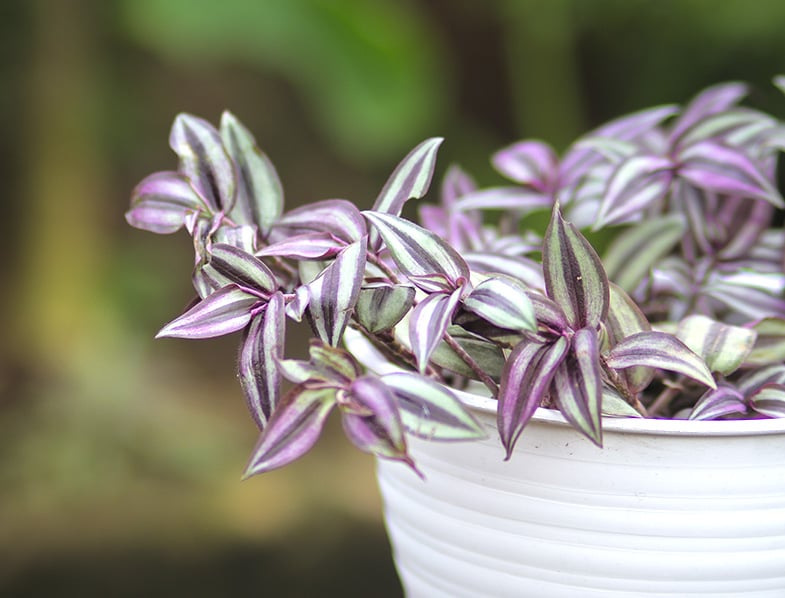
Tradescantia Fluminensis
This wandering Jew species features white flowers, and it’s a trendy indoor plant around the world. The species originates from the southeastern region of Brazil. It’s an evergreen perennial plant that flowers all-year-round and lasts for many years if the owner takes care of it correctly.
The oval-shaped foliage of the Fluminensis is green in color and has a glossy look. The leaves attach to fleshy stems, and the stem nodes quickly put roots down into the soil, allowing for the rapid spread and growth of the plant in ideal growing conditions.
When the plant flowers , it produces a set of flowers with three white petals. The flowers don’t bear any seeds, and they might also emerge in clusters. There are various sub-species of this plant as well, and some types, such as variegate, feature different leaf colors, such as yellow or cream streaks in the leaves.
The plant does best in USDA zones 9 to 12, as it loves the additional humidity in these regions as well. The wandering Jew doesn’t do well in colder climates, so stick to planting in the southern states.
The wandering Jew also prefers full sunlight during the day, and you’ll need to feed it a reasonable amount of water throughout the week. The plant doesn’t enjoy being dry for long periods.
Tradescantia Pallida
This variety originates in Mexico, and it’s the most attractive of the three Tradescantia genus. This wandering Jew produces long, pointy leaves that can reach lengths of 7-inches. The leaf will eventually turn a purple color, but the tips might remain red or green during the color transition.
There are visible segmentations on the stem of this wandering Jew, and it’s for this reason that many countries classify this plant as invasive.
The segments break easily, but they root readily, evolving into two plants with little care. Fortunately, for fans of the plant, it also makes it easy to grow the plants for cuttings as well.
Tradescantia pallida don’t like the cold, and it will die back in colder environments in the Northern states, especially if it grows outside. This wandering Jew produces small flowers that bloom in colors of pink, lavender, and white. The flowers feature three petals, and while they aren’t show-stopping, then do add a beautiful aesthetic to the plant.

- shipped in inproved box to save the plant

Last update on 2024-02-01 / Affiliate links / Images from Amazon Product Advertising API
Natural Air Cleaners
One of the reasons why the wandering Jew is such a popular house plant is its natural air-cleaning properties. The wandering Jew is an excellent “air scrubber,” and it removes bacteria and VOCs from the air inside your home, exchanging it for fresh air that enhances your home.
Some research also shows that the wandering Jew can assist in soil remediation, as well. The plant can remove heavy metals from the soil, helping restore the root health of other plants in the same flowerbed or pot.
Caring for Your Wandering Jew Plant
All varieties of the wandering Jew are easy to care for, provided that you grow them in the right climate and conditions. As long as the plant receives regular watering and pruning, it will thrive, and you’ll also manage to control the growth as well.
If you plant in a sunny spot in your home, then you can expect your tradescantia to last for many seasons. It’s also important to note that the plant might not flower it in its first season. However, by the third year, you should see plenty of flowers that emerge in the summer months.

As mentioned, the wandering Jew prefers sunny planting locations. The plant prefers later afternoon sun to morning sun, but it does well in any sunny area around the home. The more light you give the plant, the more flowers it produces in the flowering season.
If your wandering Jew does not get sufficient sunlight, you’ll notice that the color of the leaves starts to fade. Move the plant to a sunny spot, and it should recover in less than a week.
The wandering Jew enjoys a balanced moisture level in its soil . Don’t let the earth get too dry, as it might cause burning in the tips of the leaves. Likewise, the wandering Jew does not enjoy excessively wet soil either. The plant is susceptible to forming root rot if you “keep its feet wet.”
To check if it’s time to water your wandering Jew, push your finger about 1-inch into the soil. If it feels dry, then give your plant some water.
You must ensure you use a rich, loamy soil that drains well when planting your wandering Jew. When planting in a pot, make sure you add a layer of gravel at the bottom of the pot to enhance drainage. Add perlite to the soil to assist with drainage as well.
You can get away with using a standard potting mix when planting indoors , and other soil enhancements we recommend you add are the following.
- Coarse sand and perlite for drainage
- Humus or peat
- A light dusting of lime
- A few handfuls of rich organic compost
You want the soil to retain water but still allow optimal drainage.
During the growing season, fertilize your wandering Jew plant using a liquid-based fertilizer product. Make sure that you dilute the fertilizer to 50-percent strength.
Strong concentrations can result in burning in the tips of the leaves of the plant. You can also add a granular slow-release fertilizer to the soil once a year at the start of spring.
The wandering Jew grows quickly, and it might take over its pot in one or two seasons, depending on the size of the container. Therefore, you’ll need to pull up the plant and divide it from year-to-year, depending on its growth rate.
If you choose to re-pot your plant, make sure you use a pot that’s at least 50-percent larger than the old one. Line the pot with potting soil and a few handfuls of rich organic compost. Dig around the edges of the existing container to loosen the root ball. After loosening, pull the base of the plant to release it from the pot.
Move the plant to its new pot, and then fill with potting mix to cover the roots — Pat down the soil, and then water lightly.
Wandering Jew plants require regular pruning . The plant grows quickly, and if you don’t prune, then it can overtake the pot fast. Pruning also helps the stem, from getting “leggy,” meaning that the plant starts to look bare at the base. Pruning keeps the plant healthy and growing at an optimal rate.
All; you need to do is prune back any stems and pinch the stem tips. The wandering Jew will then send out two new shoots from the pinched top, helping your plant spread out into a bush-like appearance.
Propagation
The wandering Jew is easy to propagate . This plant grows quickly in a variety of conditions, which is one of the reasons why most countries list it as invasive. You can propagate your cuttings after your pruning session, without much effort.
Remove all of the leaves but the top set after pruning the stem. Place the cutting in another smaller pot with moist potting soil . Leave the container in the sun, and you should find that the cutting roots in a month.
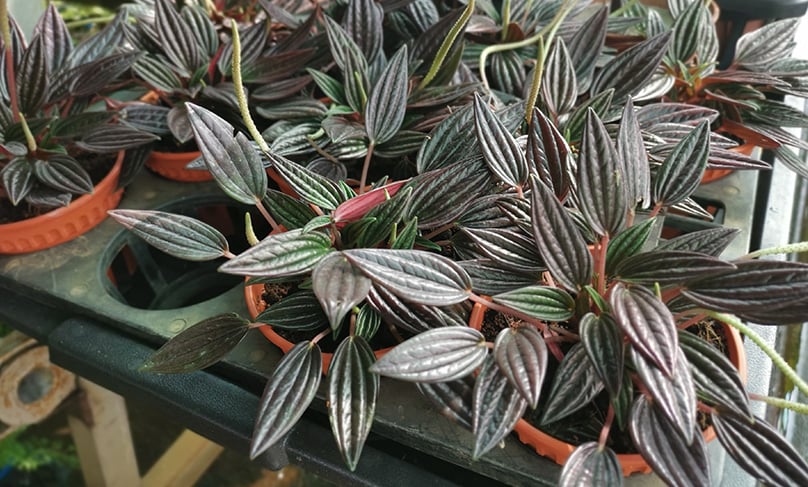
Being an indoor plant , the wandering Jew does not get much attention from pests. However, spider mites can be a problem for your plant if you don’t take care of it and watch for the presence of pests.
Spider mites are tiny spider-like bugs that form a web around the inside of the leaves of the plant. If left unmanaged and untreated, they might start to cause yellow spots in the foliage. The wandering Jew might also fail to flower in the summer months as well.
Over-watering your wandering Jew plant can result in the onset of diseases like root rot. Ensure that you have a well-draining soil mix before planting your wandering Jew. Provided that you do everything you can to ensure your soil drains well, you should never have a problem with root rot in your wandering Jew plant.
Wandering Jew Plants FAQS
What is the best way to grow a wandering jew plant.
The best way to grow a Wandering Jew plant involves placing it in a location that gets plenty of sunlight, preferably late afternoon sun. You should use well-draining, loamy soil to plant it, and ensure a balanced moisture level by watering it regularly but not excessively. The plant also appreciates humidity and occasional fertilizing with a liquid-based fertilizer diluted to 50% strength during the growing season. Pruning should be done regularly to manage its growth.
Is Wandering Jew easy to grow?
A: Yes, Wandering Jew plants are generally easy to grow. They adapt well to various conditions and are fast-growing. They can be propagated easily from cuttings and require minimal maintenance beyond regular watering, pruning, and an occasional application of fertilizer. However, they do not tolerate cold climates very well.
Does wandering Jew like full sun or shade?
Wandering Jew plants prefer locations with full sunlight. They can tolerate some shade but too much shade can cause the color of the leaves to fade. More sunlight exposure generally leads to more flowers during the flowering season.
How often do you water Wandering Jew?
Wandering Jew plants should be watered regularly to maintain a balanced moisture level in the soil. However, the soil should not be allowed to become too dry or too wet. Overwatering can lead to root rot. A good way to check if it’s time to water is to push your finger about 1-inch into the soil. If it feels dry, it’s time to water the plant.
Is Tradescantia Zebrina easy to grow?
Yes, Tradescantia Zebrina, a variety of Wandering Jew, is easy to grow. It requires similar care to other Wandering Jew varieties and is known for its adaptability and quick growth.
Does Tradescantia Zebrina need full sun?
Tradescantia Zebrina does best in a location with full sunlight. While it can tolerate some shade, insufficient sunlight can cause the leaves to lose their vibrant color. Like other Wandering Jew plants, the more light it gets, the more flowers it produces during its flowering season.

Hollie is a life-long gardener, having started helping her Dad work on their yard when she was just 5. Since then she has gone on to develop a passion for growing vegetables & fruit in her garden. She has an affinity with nature and loves to share her knowledge gained over a lifetime with readers online. Hollie has written for a number of publications and is now the resident garden blogger here at GardenBeast. Contact her at [email protected] or follow on twitter https://twitter.com/greenholliec
Pampas Grass Guide: How to Plant & Care for “Cortaderia Selloana”
Rhaphidophora tetrasperma guide: how to grow & care for “mini monstera”, corn plant guide: how to grow & care for “dracaena fragrans”.
under the photo “easy to propagate”, that is not a wandering jew-its a peperomia “rosso!”
My wandering jew plants leafs are getting dried. Why is that?
It’s not getting enough humidity
Could you elaborate on “rich organic compost”? What should it be made of, exactly? Can I use compost accelerator in the soil mix?
Worm castings are great, or worm tea, egg shell tea is another.
What month does the jew break ground to start growing?
All depends on your specific areas weather pattern and seasons.
Do NOT BUY ANY OF THIS SPECIES if you have a dog because dogs are very allergic to these plants & come out in bad rashes if they wander through them!
Leave A Reply Cancel Reply
Save my name, email, and website in this browser for the next time I comment.
Type above and press Enter to search. Press Esc to cancel.

Wandering Jew Plant – Ultimate Care Guide
By: Author Daniel
Posted on Last updated: September 18, 2023

Sharing is caring!
- Facebook 60
You are reading this guide to learn more about the Wandering Jew Plant and its care . I have had this plant at home for many years and write about all the growing aspects in this guide.
Wandering Jew Plant Care Takeaways
What is the wandering jew plant.
The Wandering Jew, or Tradescantia zebrina, by its scientific name (old name = Zebrina pendula) is native to Mexico. It is not to be confused with Tradescantia albiflora, which also goes by Wandering Jew and has very similar care needs.
Tradescantia zebrina has attractive foliage, sporting exciting zebra-patterned leaves. It also flowers. But when kept as a houseplant, this rarely ever happens. It is a fast-growing and excellent groundcover, according to the University of Florida .

W andering Jew Plant Care
To keep your Wandering Jew plant thriving, ensure it receives bright, indirect sunlight. Keep it in average room temperatures of 60-75°F (16-24°C). Fertilize once a month during spring and summer. In winter, relocate the plant to a cooler area with temperatures of 54-59°F (12-15°C).
Table of Contents
Tradescantia zebrina Growing guide
Tradescantia zebrina care is pretty straightforward, but it certainly can’t hurt to glance at the most important things to consider when caring about this herbaceous perennial plant.
So, without further ado, let’s see how you can make your Wandering Jew, aka the Inch plant, as happy as possible.
Any good potting soil will do for your Wandering Jew. For instance, this could be Miracle Gro potting soil readily available online in stores like Amazon.
But these plants not only feel very comfortable in soil but can also be kept in hydroponics .
Sunlight is a vital aspect when it comes to the well-being of most houseplants. Some houseplants do well with moderate sunlight, while others only thrive (or flower) when a certain level of sunlight is guaranteed.
The Wandering Jew does best in bright, indirect sunlight .
If you are unsure what that means, please look at our Light Levels article.
The Wandering Jew, a tropical native, thrives best when the root ball is always well moisturized. Still, waterlogging should be avoided whenever possible, as this could lead to root rot .

This tropical plant does not enjoy limy water. Use soft water whenever possible. Rainwater and distilled water are very good choices.
Temperature
People who own an Inch plant and keep it outside run the risk of exposing it to cold temperatures. This is where indoor plant owners have the upper hand.
Wandering Jews can thrive with average room temperatures of 60 to 75°F (16 to 24°C) if it doesn’t drop for long periods. Anything below 12°C for an extended period could be fatal for your Wandering Jew.
Wandering Jews prefer a humidity of around 70%
The perennial, herbaceous Wandering Jew plant is native to Mexico, Central America, and Colombia, so it should not surprise you that it likes a good deal of humidity.
To ensure high humidity levels, regularly misting your plant is a very good idea. A hand mister filled with water does the trick.
As for the location, you may want to keep your Wandering Jew in the bathroom , as this is usually the place in the house with the highest humidity.
Feed your plant once a month during spring and summer. In winter, fertilizing is not necessary.
Also, fertilization of the Wandering Jew is only necessary from the second year of cultivation or after repotting.
Propagation
It is best propagated through stem tip cuttings. Propagating the Wandering Jew is an easy task.
Wandering Jews don’t get very tall. They might reach a height of about 14 inches (36 cm) when kept indoors. They spread to about 10 inches (25 cm).
(Re)potting
The thing with the Wandering Jew is that it grows fast , hence its nickname “Inch plant.” Because of its fast-growing pace, the plant usually gets very leggy, and leaves are often lost near the base of the plant.
Repotting is pivotal for keeping the root system healthy regardless of the actual plant species. However, how often a houseplant needs to be repotted depends on various factors.
Some houseplants grow incredibly fast, so they need to be repotted often. Others, on the other hand, grow very slowly, so repotting is not a top priority.
That said, repotting your Wandering Jew occasionally is a good idea.
How long does a Wandering Jew live?
As far as the longevity of Wandering Jews goes, they often don’t get older than 2 to 3 years.

Wandering Jew Watering
Water about once every 5-7 days in spring and summer. Keep the soil slightly humid. Do not let the Wandering Jew dry out between waterings. Use your index finger to check if the soil is dry down 1-2 inches of soil (2.5 – 5 cm).
Reduce watering to every 10-14 days in autumn and winter.
Wandering Jew Propagation
The Wandering Jew roots very easily . The plant can easily be propagated through stem tip cuttings.
When propagating your Wandering Jew, make sure that your plant is in a healthy condition.
Please follow our step-to-step guide to propagate your Wandering Jew through stem tip cuttings.
Propagation through stem tip cuttings
- Identify the plant that you want to replicate. It should have healthy growth and plenty of stems.
- Make clean cuts on sections that are three to six inches in length .
- Use a sharp knife and carefully cut the leaves on the stem’s bottom half.
- If you want, you can dip the exposed end of the stem in a rooting hormone . This will speed up the rooting process. However , it is unnecessary .
- Place your stem tip cuttings into a pot with fresh soil after thoroughly watering the potting mixture.
- Use a clear plastic bag to hold in moisture, taking it off to water weekly .
- Keep your eyes on the plant for new growth . You should start to see roots in about two to three weeks . Once this happens, transfer the plant babies to a larger pot.
Note: Instead of rooting your stem tip cuttings directly in soil, you could also root them in water .
Wandering Jew Pest Control
Wandering Jews are prone to aphids and spider mites attacks. So, you will need to look out for these two little pests.
Some of these are known to cause defoliation, while others can kill the plant altogether. Depending on the severity of the infestation, you may need to use chemicals or insecticides .
Aphids on my Inch Plant
The Wandering Jew is not particularly susceptible to plant diseases or pests. Yet, you might have to deal with an aphid attack at some point. These parasites pierce the leaves of their host plant and suck their sap.
Like scale insects, they excrete sticky honeydew, by which you can immediately recognize the infestation.
Aphids can multiply explosively, especially in warm , dry environments.
As a preventive measure, ensure regular watering and occasional misting of your Wandering Jew.
The best way to combat aphids is to control them mechanically by rinsing them off the plant with water . Isolate the plant from the rest of the collection.
Pest Prevention
To prevent the Wandering Jew from pest infestations, plucking dried leaves regularly makes sense as well as using neem oil. The dried leaves lying on the substrate must be removed. Otherwise, there is a risk of rotting or infestation by parasites and fungi .
Wandering Jew Problems
Brown leaf tips.
Brown leaf tips is a very common problem with a wide variety of houseplant. Depending on the species, the causes for this problem can be very different, though.
So what causes leaves to turn brown with Wandering Jews?
My Wandering Jew has only green leaves (not enough variegation)
If you do own a variegated Wandering Jew but only see a great amount of non-variegated leaves, chances are that your plant does not get enough sunlight .
To solve the problem, allow your Wandering Jew some bright, indirect sunlight by placing it in a sunnier location.
Fading leaves
If your inch plant’s foliage is suddenly losing color and sports fading leaves, this is another sign that it does not get enough sunlight .
Dropping leaves
Dropping leaves is another very common problem many plant parents must deal with regularly . If your Wandering Jew drops leaves, this is usually due to too low or too high temperatures .
In summer , ensure your Wandering Jew is exposed to average room temperatures.
In winter , it should be kept in a cooler environment.
Is Wandering Jew care difficult?
Wandering Jews are considered low-maintenance plants and are perfectly suitable for beginners.
They do well at average room temperatures, don’t demand a very high level of humidity (which is sometimes difficult to achieve in a home environment), and it is very easy to propagate them through stem tip cuttings.
Which plant species are commonly referred to as “Wandering Jew”?
Tradescantia zebrina as well as Tradescantia albiflora.
What is the difference between Tradescantia zebrina and Zebrina pendula?
There is no difference between Tradescantia zebrina and Zebrina pendula. Zebrina pendula is just the old name for Tradescantia zebrina.
Does my Wandering Jew flower at all?
Wandering Jews are indeed flowering plants. However, when kept indoors, they very rarely flower.
How long can you keep a Wandering Jew?
If you don’t propagate your Wandering Jew, you can keep it for about three years. After that period, the quality of your Wandering Jew will most likely decrease. If you regularly propagate your leafy friend through stem tip cuttings, you can keep it indefinitely.
Any display tips for Wandering Jews?
Wandering Jews look great in hanging planters!
Is the Wandering Jew toxic to cats?
The Wandering Jew plant is toxic to cats. Therefore, you have to keep your cat away from this plant.
Is the Wandering Jew toxic to dogs?
Yes, the Wandering Jew plant is toxic to dogs. Therefore, you must ensure your dog does not come in contact with this plant.
What are the health benefits of Tradescantia zebrina, if any?
Not only is The Wandering Jew a beautiful houseplant famous for its striking foliage, but it also presents several health benefits for humans. It is especially known for its antioxidant and antibacterial activity, and it is widely used in Traditional Medicine in several countries. Tradescantia zebrina is also believed to be a valuable source for treating kidney diseases.
The Last Zebrina
The Wandering Jew is a great houseplant that looks stunning in hanging planters. Its care is easy apart from its humidity-loving nature.

Daniel has been a plant enthusiast for over 20 years. He owns hundreds of houseplants and prepares for the chili growing seasons yearly with great anticipation. His favorite plants are plant species in the Araceae family, such as Monstera, Philodendron, and Anthurium. He also loves gardening and is growing hot peppers, tomatoes, and many more vegetables.
Related Posts
(image credits, IG:oohyouplantsy) I have a hide-away in my home that I escape to for…
How much light does my plant need? This is a relevant question as too little…
I love plants that offer an eye-catching burst of color. They sure put a smile…
Most of the 45+ species in the Monstera genus are famous for their unusual leaves…
One of the rarest Anthuriums is the Anthurium Reflexinervium, a gorgeous plant naturally found only…
Hoya Lauterbachii belongs to Hoyas's family, which are known to be the largest plants on…

Wandering Jew Plant (Tradescantia zebrina): Types, How to Grow and Care
Sharing is caring!
Plants with trailing and creeping habits are some of the best plants to keep. They are fast-growing and make thick carpet of groundcovers for gardens in no time and they also create striking hanging indoor plants.
Among the all-time best trailers to grow is the wandering jew. Easy to maintain and drapes beautifully, this colored plant will make any space more inviting and interesting.
Medicinal Properties
Propagation and maintenance, what is a wandering jew plant.
Tradescantia is one of the 37 genera under the plant family Commelinaceae (1). Some of its 75 species are commonly called ‘wandering jew’ (also known as inch plant), a name they adapted due to their long lifespan like the Jewish character from a Christian folklore.
Another name for this group of herbaceous perennial plants is ‘spiderwort’ after the spiderweb-like sap they produce when the stem breaks. They are native to Canada, Mexico, and Argentina and have been naturalized in other parts of the world (2).
The most common tradescantia grown ornamentally is the T. zebrina also previously called Zebrina pendula . It has long fleshy stems where the wandering jew plant leaves and roots appear. The lance-like leaves are a mixture of green and purple with silver stripes on the upper side and deep purple under (3). The plant grows close to the ground and can only reach 20 to 30 cm high.
Does Tradescantia Zebrina Flower?
The wandering jew is considered an ornamental plant primarily because of its showy colorful foliage but the plant does produce pink flowers.
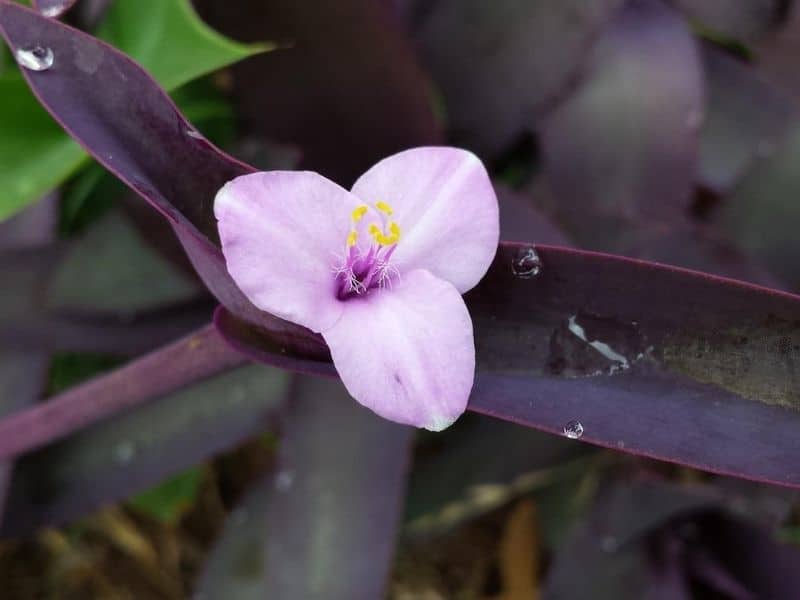
Small three-petaled pinkish purple flowers appear sporadically throughout the year (4). The resulting fruit is a capsule containing tiny brown seeds.
Is it Toxic to Pets?
Spiderworts are normally harmless plants but they contain toxic properties that may cause mild gastric problems and dermatitis to pets. Although they don’t lead to anything serious, it will be safe to keep the plants out of reach of pets and to keep the hands protected when dealing with the sap of the plant.
Because of the plant’s hardiness and adaptability to different environments, the wandering jew establishes well, in fact so well that it can be considered an invasive species. In countries like Australia, the plant has the capacity to invade natural vegetation. Although growing them is not prohibited, everyone is obliged to keep the plant’s growth under control (5).
Studies showed that Tradescantia has significant effects as an anticancer, antioxidant, and antibacterial medicinal plant. In traditional Chinese medicine, the wandering jew plant is highly valued as treatment for kidney failure.
The extract from the whole plant is cooked with dates, ginger, and water and consumed by patients. The plant is also known to treat high blood pressure, cough, urinary tract infection and tuberculosis (1).
How to Grow and Care for a Tradescantia
Here’s how to care for a wandering jew plant, one of the easy house plants to own.
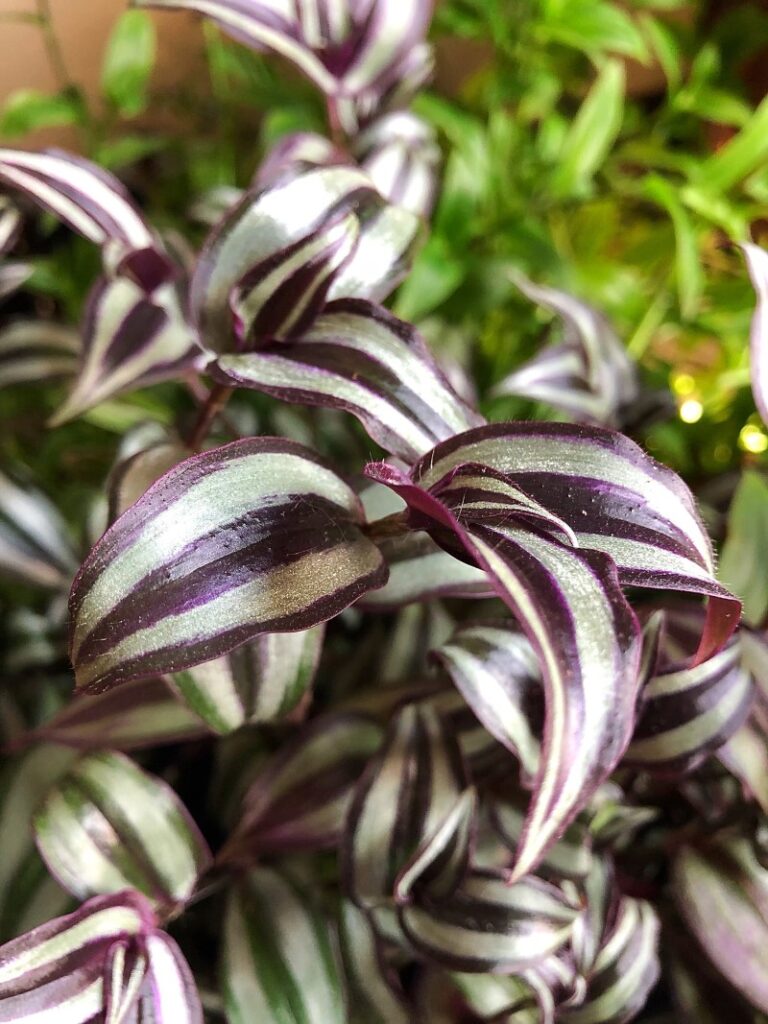
Light and Water
In the wild, the wandering jew plant thrives without assistance but under the right conditions. It likes filtered sun so indoor fluorescent light is enough. Placing them by the window and turning the plant every two weeks will keep the leaves colorful and the growth even on all sides (3).
The plant spreads easily in damp areas that’s why it naturally grows along riverbanks and roadsides. When potted, the soil should be kept moist but well-drained. Saturated soil often causes root rot.
Fertilize your Tradescantia plant once a month during the growing season (spring and summer) with a balanced, water-soluble fertilizer diluted to half strength. Avoid fertilizing in fall and winter when the plant is dormant. Over-fertilizing can lead to fertilizer burn and damage the plant, so follow the instructions on the fertilizer package carefully.
Temperature and Humidity
Spiderworts like it warm but there should be enough air circulation or else the leaves will sag. During the heat of the summer, taking the plant outside under shade will provide the necessary cool to the plant.
Mist the hanging plant early in the morning and late in the afternoon. If the plant is on a table, place a glass of water beneath the leaves or put the pot on a wet pebble tray. This will humidify the immediate vicinity of the plant aiding in its photosynthesis and transpiration processes.
Pests and Diseases
The most common living enemies of the wandering jew are aphids, mealybugs, scale, white flies, and spider mites. Manual removal at the onset of infestation is effective but they should be closely monitored as serious attack may lead to the plant’s death. If left unnoticed and the infestation has become severe, get rid of the plant by burning to avoid contamination.
Since the creeping inch plant is mainly soft almost like a succulent, soggy soil and too wet conditions lead to root and stem rot (4). As long as the plant is receiving just enough moisture, this disease will be avoided.
Propagating wandering jew plants is very easy. They can grow from seeds but will take years to establish so the more convenient stem cutting is best. The trailing or creeping stems form nodules where the roots will eventually grow as it comes in contact with the potting soil (2). When the hanging plant has longer trails than intended, it can be trimmed and the resulting stem cuttings can be rooted to form new plants.
There will be times that the potted wandering jew will become leggy, especially if it’s been receiving more shade. To promote a bushier growth pinch back by literally pinching the tip of the plant where the new growth occurs (4). This practice allows the formation of lateral stems.
In two or three years, these hardy plants may become pot bound, with the roots taking up most of the space in the pot. Repot in a larger container with a good mixture of soil, coarse sand, and compost to replenish the nutrients and provide room for the roots to breathe. Additionally, fertilize once every two months by foliar application just to improve plant vigor.
Common Varieties of Wandering Jew
The oldest and most common indoor wandering jew, this species has leaves alternating, often overlapping when young, purple leaves with silvery green thick stripes and solid purple underside. The stem is also a mixture of purple and green.
T. blossfeldiana
The leaves of this species are quite thicker, glossy, and covered in miniscule hairs called trichomes. The three-petalled flower is an ombre of white and pinkish purple with yellow anthers.

T. fluminensis ‘Tricolor’
This attractive variety showcases leaves with white, lilac, and green variegation. It appears smaller than the common wandering jew but bushier in form.
T. sillamontana
This whimsical species looks frosted with its silvery trichomes covering the entire plant. The green leaves are still alternately arranged but more compact which make a potted plant look more bushy than trailing. The light color of the leaves provide a complementing backdrop to the bright purple flowers.
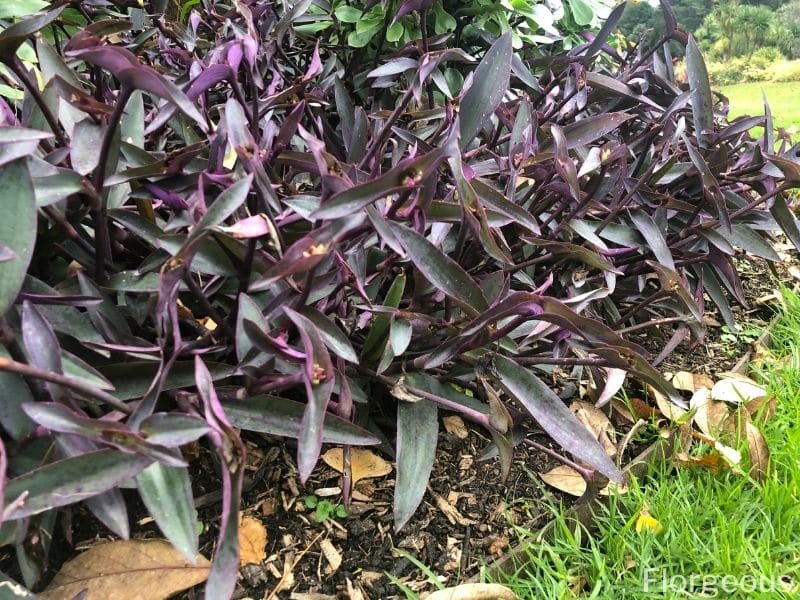
The leaves and stems of this species are in striking deep purple color hence the common name ‘ purple heart ’. Under shaded, they turn a hint of dull green. The leaves are also longer and have wider space in between.
Does Wandering Jew plant need full sun?
Wandering Jew plants (Tradescantia zebrina) prefer bright indirect light but can tolerate some direct sun, especially in the morning or late afternoon. However, prolonged exposure to intense sunlight may cause their dark green leaves to scorch.
How do you care for a wandering Jew plant indoors?
To care for a Wandering Jew plant indoors, place it in a location with bright, indirect sunlight, such as near a window. Water it when the top inch of soil feels dry, typically every 1-2 weeks, and provide well-draining soil. Additionally, mist the plant occasionally to increase humidity and remove dust from the leaves.
How do I make my Wandering Jew fuller?
To make your Wandering Jew plant fuller, prune it regularly to encourage branching and bushier growth. Pinch off the tips of the stems or trim back leggy growth to promote new growth and create a more compact appearance. You can also propagate wandering jew cuttings to create new plants and fill out the pot.
How long do Wandering Jew plants live?
Wandering Jew plants are generally long-lived when provided with proper care. With the right growing conditions indoors, they can thrive for several years, often becoming fuller and more lush over time with regular pruning and maintenance.
Reference List
(1) Dash, G., et. al. Tradescantia zebrina: A Promising Medicinal Plant. 2017. IAJPS, 4 (10). P. 3498-3502 .
(2) Arakelyan, H. Tradescantia zebrina- Mother Nature Healing. 2019. Researchgate.
(3) Vermeulen, N. Encyclopedia of House Plants. Taylor and Francis. 1999. P. 320.
(4) North Carolina State Extension. Tradescantia zebrina. NC State University. 2018. https://plants.ces.ncsu.edu/plants/tradescantia-zebrina/ . Accessed on 12 August 2020.
(5) The State of Queensland. IPA-Zebrina. Department of Agriculture and Fisheries. 2020. https://www.daf.qld.gov.au/__data/assets/pdf_file/0020/51284/IPA-Zebrina-PP102.pdf . Accesed on 12 August 2020.
Photo by Wirestock/depositphotos
Have you seen these?
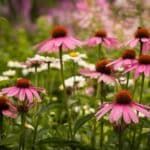
5 Best Coneflower Companion Plants and The Worst to Avoid
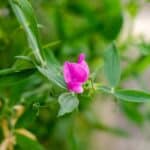
Enhance Blooms & Soil Health: Top 12 Companions for Sweet Peas
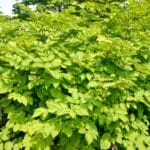
6 Best Aralia Sun King Companion Plants and Landscaping Ideas
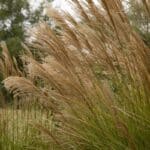
Growing and Caring for Maiden Grass (Miscanthus sinensis)

How to Grow and Care for Fountain Grass (Pennisetum)
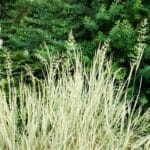
Growing and Caring for Blue Oat Grass (Helictotrichon sempervirens)
About the author.
Grow. Play. Every Day!

- House & Home
- Houseplants
Wandering Jew Plant Care: Complete Growing Guide for Tradescantia Zebrina (Inch Plant)
Tradescantia zebrina (commonly known as wandering Jew, spiderwort, or inch plant) is popular for a reason: This beginner-friendly houseplant is low-maintenance and grows quickly. It’s also super easy to propagate more plants so you can fill your home with more of the colorful striped foliage the species is known for.
Written by Linda Ly

When it comes to vigorous, colorful, and easy-to-grow hanging houseplants, there aren’t many that can compare to Tradescantia zebrina (known more commonly as wandering Jew—and I’ll touch on the history of that name below). Whether you’re a houseplant beginner or a veteran, most indoor gardeners have owned one of these potted plants at some point.
Keep reading for everything you need to know about Tradescantia zebrina and growing this stunning houseplant in your own home.
Disclosure: If you shop from my article or make a purchase through one of my links, I may receive commissions on some of the products I recommend.

About inch plants
Natural habitat.
Tradescantia zebrina is a native of Central and South America, from Mexico down to Colombia, as well as the Caribbean. Here, it forms part of the undergrowth in lightly forested and often very moist areas. It can form very dense, wide mats thanks to its creeping growth pattern and ability to throw roots extremely quickly.
Unfortunately, its vigorous growth has also made Tradescantia zebrina an invasive plant in some regions. This includes Hawaii, Brazil, and Australia, where the species easily takes hold in moist, forested areas.
As a 2019 study carried out in the Brazilian Atlantic Rainforest notes, this is problematic due to the species choking out native plants.
Some of the above was caused by careless gardeners allowing bits of the plant to get into the wild, where they quickly root. If you’d like to grow spiderworts like this one in your garden, please make sure to dispose properly of any trimmings left after pruning!
This also applies to zebrina’s popular cousins, like Tradescantia fluminensis, T. pallida, and T. spathacea.
Description
It’s not difficult to see why Tradescantia zebrina gained popularity as a houseplant. Wandering spiderwort plants (not to be confused with spider plants , another beginner-friendly species) are low-maintenance and grow just about anywhere—they even just grow in water !
Easy care and quick growth aside, spiderworts are also just good-looking plants. The pointed, oval leaves on thin, fleshy stems overlap slightly and are characterized by their zebra pattern in purple and silvery green. The leaf undersides are deep purple in color and the tiny, three-petaled flowers are bright pink.
Although this species is naturally a creeping plant, it’s often grown indoors in hanging planters. As long as the plant is provided with enough light, the foliage will be very dense and brightly colored, forming a spectacular waterfall that can reach more than 3 feet in length.
What’s in a name? In the case of common houseplants, sometimes a lot.
Tradescantia zebrina is a classic houseplant (I found mention of it in a 1964 German book about houseplants, but it’s probably been around longer than that!) and among most English speakers, it has long been known as wandering Jew. This is probably a reference to the “wandering” nature of the plant, as it does have a creeping growth pattern.
The legend of the wandering Jew is hundreds of years old and is now commonly considered to be rooted in antisemitism. It describes a Jewish man cursed to walk the planet until the Second Coming because he taunted Jesus on his way to the cross.
Because of this, the plant name has partly fallen out of fashion and has been the source of much debate in the plant world over the past few years.
Some plant enthusiasts have embraced the alternative “wandering dude,” which I personally think is a great option.
“Inch plant” (houseplant enthusiasts don’t agree on whether this refers to the fact that it can grow an inch a day, or that you only need an inch of stem to propagate it), “spiderwort,” or “wandering spiderwort” are also popular alternatives, though these are common names for other Tradescantia varieties, such as Tradescantia Nanouk.
The best way to avoid any confusion is to just stick to the scientific name.

Inch plant varieties
There are three subspecies of inch plant (wandering Jew): Tradescantia zebrina var. zebrina, var. flocculosa, and var. mollipila. Unsurprisingly, after it having been a popular houseplant for so many years, nurseries have also managed to create a whole bunch of cultivars through selective cultivation.
A few of the popular Tradescantia zebrina cultivars you may come across in your local plant store include, but are certainly not limited to:
- Tradescantia zebrina ‘Quadricolor’: Yep, as the name suggests, this one adds an extra color to the mix. The leaves are cream, pink-purple, light green, and dark green.
- Tradescantia zebrina ‘Burgundy’: Characterized by its very dark purple coloration.
- Tradescantia zebrina ‘Silver Plus’: Less purple, more shiny silver.
- Tradescantia zebrina ‘Red Gem’: Less silver, more intense (light) purple.
- Tradescantia zebrina ‘Purple Joy’: Less silver, more dark purple.
- Tradescantia zebrina ‘Tikal’: A rare, naturally occurring variety that collectors pay a pretty penny for.
Do keep in mind that most of these cultivars aren’t patented and the amount of mislabeling and variation within a cultivar are both huge. Just growing your wandering Jew in lower-light conditions can completely change the way it looks, so it’s not surprising that confusion sometimes reigns supreme.
Luckily, care is the same across all cultivars, so your best bet is to just enjoy your plant even if you’re not sure what Tradescantia variety you’re dealing with!
Where to buy wandering Jew plants:
- California Tropicals
- Daylily Nursery
- The Green Escape

Caring for an inch plant
Light and temperature.
It’s important to provide your Tradescantia zebrina with enough light. It’s tempting to use plants to brighten up dark, shaded spots in your home, but that just doesn’t work with this one: It loses its dense growth pattern and beautiful coloration in low light.
To prevent your wandering dude plant from growing sparse and green, place it near a window that gets bright indirect light. Some full sun isn’t a problem either, but do make sure you acclimate it gradually to a higher light location.
Temperature-wise, this species is a lot hardier than many of the tender tropicals we like to grow in our homes (like Anthurium andraeanum and Begonia maculata ).
Wandering dude plants can handle a very wide range of temps, making it perfect for those chillier windowsills that your other plants may not appreciate. Room temperature is ideal, but anything between 50°F to 85°F will keep them happy.
Water and humidity
Your Tradescantia zebrina will appreciate lightly moist soil. You can water a bit more during the summer months, when the plant is actively growing and needs a lot of moisture, and less during winter, when soil tends to take significantly longer to dry.
If you’re not sure whether it’s time to water your wandering Jew plant yet, you can always turn to the age-old trick of sticking a finger in the soil.
- If it still feels damp, wait a little longer, until the first inch or two has dried.
- If it feels bone dry, you’ve waited too long; you may also see limp leaves on your plant at this point. It’ll bounce back, but not always without lasting damage.
- If the soil feels wet, you watered too much and need to keep an eye out for root rot.
As for humidity, given its rather wet natural habitat, wandering Jew does appreciate higher air moisture levels. The great thing is, though, that it doesn’t demand it. As long as you keep its soil lightly moist and the air isn’t extremely dry, your plant should do well.
Soil and planting
Wandering Jew is not fussy about its potting mixture at all. I’ve grown it in pure houseplant potting soil with no additives. If you do want to take things to the next level, you can add some perlite and/or peat moss, although this is really not a must.
Most houseplant enthusiasts like to place their wandering Jew in a hanging planter so they can enjoy the look of the leaves cascading down. This is not a must, though. You can also emphasize the species’ creeping growth habit by filling up a large, shallow planter, growing it in a terrarium, or even keeping it in water on a semi-permanent basis.
Recommended products for wandering Jew plant care:
- FoxFarm Ocean Forest Potting Soil
- Espoma Organic Potting Mix
- Perfect Plants Organic Perlite
Fertilizing
Like most other houseplants, Tradescantia zebrina appreciates a bit of fertilizer during the growing season, which extends from spring to early fall. You can use a normal houseplant fertilizer according to the instructions on the bottle.
Don’t fertilize during the winter months unless your plant is growing well. It doesn’t need extra nutrients if it’s inactive.
Recommended fertilizers for wandering Jew plants:
- Houseplant Resource Center Liquid Fertilizer for Houseplants
- Instant Biologics Instant Plant Food (Fizzing Nutrient Tablets)
- Maxsea All-Purpose Seaweed Plant Food
Pruning
There’s a good chance you’ll have to prune your Tradescantia zebrina regularly, because as I mentioned, this is a very quick grower. It also roots very easily, so any trimmings can be replanted! I’ll describe how to do this in the section on propagation below.
Aside from stem trimming, you can remove any dead leaves, which are bound to pop up from time to time in very dense plants like this species.
Dividing or repotting
Inch plants don’t grow by producing plantlets at their base like many other houseplants (such as spider plants ) do. Instead, inch plants spread by rooting along the stems.
This means that division is not really the way to go; keeping these plants manageable is usually done through pruning. You can shape your plant by pinching off any long, leggy stems to create a fuller appearance and control its spread.
You’ll notice that Tradescantia really doesn’t mind being a bit cramped in its planter. Still, it’s a good idea to provide your plant with some fresh soil every year or two by repotting it.

Propagating an inch plant
If you’ve never propagated a houseplant before, this is truly one of the best species to start with. It’s known for rooting extremely quickly in both water and soil, meaning it’s easy to fill endless planters to keep or give away.
All you need to propagate your Tradescantia zebrina is a pair of clean scissors. Here’s how you do it:
- Snip the ends off existing branches. An inch or two with a few leaves works best.
- Remove the leaves at the bottom so part of the stem is exposed.
- Place the cutting in a glass of water to root or plant it directly in soil. You can put cuttings back in the mother plant’s pot to give her a fuller appearance on top.
- It can take a little longer during the winter months, but the first roots should appear within a week or so. You can give soil cuttings a slight tug to verify they’ve rooted.
- Once the first signs of new foliage appear, you’ll know your propagation attempt has been a success!
- If you propagated in water, you can leave the rooted cuttings in water almost indefinitely, although you can also pot them up in fresh soil.

Common questions about inch plant care
How do i make a wandering jew plant bushy.
By their very nature, wandering Jew plants are not bushy. Their creeping growth habit means they naturally grow leggy over time, especially in containers.
However, you can mimic a fuller appearance by strategically pinching off any long, spindly stems to shape the plant more. These stems can also be replanted near the mother plant.
As the baby plants grow, they’ll help fill in sparse areas and create the illusion of a bushy wandering Jew.
How long do wandering Jew plants live?
Wandering Jew plants have a limited lifespan of just a few years, and as a potted plant, you’ll notice your wandering Jew becoming very leggy after just two to three years.
Unlike other fast-growing plants that benefit from pruning, cutting back a wandering Jew doesn’t work well to renew its growth; it simply controls the spread.
The best way to keep your plant coming back year after year is to propagate new plants from stem cuttings, which—fortunately—is super easy with a high success rate.
Is wandering Jew perennial?
Wandering Jew (Tradescantia zebrina) is a trailing evergreen perennial in its native habitat (USDA hardiness zones 9 through 12). Where it’s not winter hardy, wandering Jew is grown year-round as a houseplant.
Are wandering Jew plants toxic to cats and dogs?
Wandering Jew is not considered outright toxic, but it can cause some skin irritation. If your pet gets into your plant, don’t worry too much, although it can be a good idea to have a look in its mouth to make sure there’s no excessive swelling. Be sure to offer water. To prevent skin rash, it can be a good idea to wear gloves if you need to handle your wandering Jew plant. This especially applies if you have sensitive skin.
https://www.cabi.org/isc/datasheet/110354
Racism in Taxonomy: What’s in a Name?
Chiba de Castro, W. A., Xavier, R. O., Garrido, F. H., Romero, J. H., Peres, C. K., & da Luz, R. C. (2019). Fraying around the edges: negative effects of the invasive Tradescantia zebrina Hort. ex Bosse (Commelinaceae) on tree regeneration in the Atlantic Forest under different competitive and environmental conditions. Journal of Plant Ecology, 12(4), 713-721.
Encke, F. (1964). Pflanzen fur Zimmer und Balkon; Auswahl, Pflege, Vermehrung.
I'm a plant lover, passionate road-tripper, and cookbook author whose expert advice and bestselling books have been featured in Time, Outside, HGTV, and Food & Wine. The National Parks Cookbook is my latest book. Garden Betty is where I write about modern homesteading, farm-to-table cooking, and outdoor adventuring—all that encompass a life well-lived outdoors. After all, the secret to a good life is... Read more »
We bought a full grown Bolivian Jewel mid summer last year. It was in a 14” raised pot and flowing 2 foot over the sides. It was beautiful next to our fountain outside. We live in Minnesota so we had to discard it in the late fall since we had no place to care for it in the house. Since we can’t find another like it we’d like to plant one from scratch but how. We still have the pot and riser but have no idea how to start from that. One plant, a few or just how many to make a bushy over grown plant so it looks like the one we purchased last year. Does this make sense or should we just forget it since it is already the middle of May. The greenhouse that we bought it from last summer doesn’t have any this year, just small ones in 4” pots. Thanks
If you can only grow it as an annual (and won’t be overwintering it indoors), you can plant a few smaller ones together to make them look fuller as they grow.
It seems counterproductive to talk about the problematic origin of the name wandering Jew, recommend multiple alternative names (including scientific), but then continue to call it wandering Jew in the rest of the article. If the name is anti-Semitic just set a good example and use a different name.
Leave a Reply Cancel reply
Your email address will not be published. All fields are required.
Save my name and email in this browser for the next time I comment.
This site uses Akismet to reduce spam. Learn how your comment data is processed .
Recommended Reads
- Garden of eatin’

The No-Dig Garden Method: Make Amazing Soil With Less Work

Solarizing Your Garden: How to Use the Sun to Control Weeds and Pests in the Soil

How to Plant a Three Sisters Garden: The Original Companion Plants

How Much to Plant for a Year’s Worth of Food

What You Should Know Before Buying Land (My Real-Life Tips)

Construction Loans: What I Wish I’d Known As a First-Time Borrower

Dark Room? 9 Actually Low-Light Plants That Don’t Need a Lot of Sun

Getting Rid of Fungus Gnats: 11 Remedies That Really Work

My Favorite Ruby Red Sauerkraut Recipe (and Why It’s So Good For You)

How to Make Nukadoko (Fermented Rice Bran Bed) for Pickling

Easy 4-Ingredient Colorful Homemade Pasta—No Pasta Maker Needed

The Best Homemade Limoncello
Subscribe to my newsletter.
Get my best secrets, practical tips, useful resources, and real stories from my own experiences.
- About Linda Ly
- What’s In My Garden
- Lazy Gardening Academy
- Sponsorships
- Site Policies

Back to the top
Disclosure: Garden Betty independently selects products to feature on this site. I may receive a commission when you buy something through one of my links. As an Amazon Associate, I earn from qualifying purchases.
© 2024 Garden Betty. All Rights Reserved.

- Search Please fill out this field.
- Manage Your Subscription
- Give a Gift Subscription
- BHG Archives
- Newsletters
- Sweepstakes
- Houseplants
How to Plant and Grow Tradescantia
These long-stemmed plants can be grown as groundcovers or houseplants.
Sharon is a writer and contributor at Better Homes & Gardens, where she writes, edits, and updates content on the website, refreshing recipes and articles about home design, holiday planning, gardening, and other topics. Before joining Better Homes & Gardens, Sharon began her career as a blogger, then became a freelance writer, focusing on home design and organization, midlife and empty nesting, and seniors and eldercare. Her work has been published on a range of websites, including Angi, Purple Clover, HuffPost, Grown and Flown, Seniors Matter, AARP’s the Girlfriend and the Ethel, and many other outlets.
:max_bytes(150000):strip_icc():format(webp)/IMG_1416-a01ec3330c39478a8fd9c93c3fa3f5d1.png)
- Where to Plant
Pests and Problems
- Propagation
- Companion Plants
- Garden Plants
Frequently Asked Questions
BHG / Kelli Jo Emanuel
Growing tradescantia (also known as spiderwort) might cause flashbacks to the 1970s but it still merits its popularity as a houseplant or a groundcover. This tough tropical plant can have trailing or upright stems and colorful foliage . Depending on the species, tradescantias are typically purple and often variegated with silvers, greens, creams, even pinks, and occasionally gold. Many of the light-foliage varieties have dark purple undersides, which creates a dramatic effect.
Though not the main reason they are grown, many varieties produce small flowers that grace the attractive foliage. Most often these three-petal blossoms are pink, purple, or white and typically at the stem tips. However, in some species these flowers are at the base of the leaves in oysterlike clusters, hence the common name of oyster plant.
Tradescantia Overview
Where to plant tradescantia.
If you're planting tradescantia indoors, put it near a window that gets bright, indirect sunlight. If your tradescantia is planted outside, you'll need to check which variety you have before deciding where it will go. For the most part, these plants do best in full sun (except where it's very hot in the summer), but do well in shade, also.
Tradescantia Care Tips
Members of the Tradescantia genus are some of the simplest plants to grow, requiring little maintenance. They're also super easy to propagate and makes a wonderful pass-along plant for friends.
Tradescantias are quite tolerant of different sun exposures. For the best coloring, plant in full sun , which generates the most blossoms possible. Inside, they tolerate just about any light level, but in shade, they may become washed-out looking. Too little sun causes leggy growth , meaning the stems grow in a stretched out way with few leaves on them. Indoor plants will benefit from spending some warm, sunny days outside in summer.
Soil and Water
Provide tradescantia with general-purpose potting mix and good drainage. When planted in the garden, most tradescantias prefer growing in moist soil with a pH pf 5 or 6. In warmer climates, they work beautifully as groundcover. Many of the trailing varieties form dense mats and will root everywhere the plants touch the ground.
Because of their fleshy stems, tradescantias can withstand an occasional drought. If they wilt, they'll usually perk up quickly after a good watering. In containers, water these plants regularly to keep the soil consistently moist.
Temperature and Humidity
Tradescantia will be happy in the same type of environment most people like. An indoor temperature of between 60-80°F is best for them. If tradescantia is grown outdoors, bring them in before the first frost , which can kill them.
You don't have to feed Tradescantia, but they'll grow more robustly if you do give them a little fertilizer . Only add fertilizer to Tradescantia in the spring and summer. Use liquid fertilizer at half strength each month, or use a controlled-release fertilizer at planting time.
Though it may not be necessary, an occasional pruning and grooming of tradescantias will make for a more appealing plant. Some types tend to lose their lower leaves, creating unattractive naked stems. This is easily remedied by pinching the growing tips to encourage more branching.
Potting and Repotting Tradescantia
Choose a pot with drainage holes and use fresh potting mix when you are planting tradescantia in a container. These plants don't need repotting very often , but if you notice roots poking out of drainage holes, choose a slightly larger container to move your plant into. The best time to repot tradescantia is in the spring.
The biggest pest for tradescantia is aphids, which can be washed away with a strong spray of water. Other than that, there aren't a lot of issues that affect these plants. Keep an eye on their leaves for any signs of bugs, but diseases are rare for this genus.
How to Propagate Tradescantia
Tradescantia can be propagated by division or from cuttings. Older plants with lots of growth are perfect for starting new plants from cuttings . This is easily done by snipping off a few inches of stem, removing the lower leaves (leave a few at the tip), and sticking the cutting in water or damp soil. When starting cuttings in water, once roots emerge, transplant to evenly moist soil. Cuttings in summer and fall will respond best to replanting.
Types of Tradescantia
There are 75 types of Tradescantia . Here are just a few of the most popular varieties you can grow.
Tradescantia spathacea has striking foliage, green on top and purple-maroon beneath. Its small white flowers are cradled in leaf axils, giving it the other common names of Moses-in-the-cradle and oyster plant. It is also sometimes called Rhoeo spathacea .
Silver Inch Plant
Tradescantia zebrina is a traditional easy-care houseplant with variegated olive and silver foliage with purple undersides. There's also a variety with leaves that are purple on both sides with silvery green stripes on the upper surface. Stems root readily in water or where they come in contact with soil.
Purple Heart
Tradescantia pallida 'Purpurea' also goes by the name Setcreasea purpurea . It is sometimes grown as a groundcover outdoors. Indoors it needs bright light to bring out its attractive deep purple coloration. It can form small, short-lived, bright pink flowers.
Striped Inch Plant
Tradescantia fluminensis is a fast-growing vine with creamy yellow striations on its leaves. It is also known as Tradescantia albiflora .
'Tricolor' Boat Lily
Tradescantia spathacea 'Tricolor' is a striking white, magenta, and green variegated form of boat lily. It has a finer texture and trails more readily.
White Velvet Spiderwort
Tradescantia sillamontana has medium green leaves densely covered in woolly white hairs. Magenta-pink flowers in summer stand out against the silvery-white foliage.
Tradescantia Companion Plants
Giant wood fern.
Giant wood fern is a shade-loving tough plant with a bold texture.
Foamflower is a low-growing perennial with white flowers.
Perfect for shade, corydalis is a perennial with showy blossoms.
Garden Plans for Tradescantia
Woodland garden plan.
Add color and foliage to a shady spot with this garden plan that includes three spiderworts.
If left unchecked, some groundcover tradescantia plants can become invasive. In fact, in South Africa and the Galapagos Islands, it's been classified as invasive and is no longer allowed to be planted or propagated. In the United States, the white-flowered spiderwort has been found to be invasive in some parts of the country, especially in Southern California and parts of South Florida.
Tradescantia gets its name from Englishman John Tradescant, who first brought the plant to England from its native Mexico in the 17th century when he was documenting plants he found in the New World.
One type of tradescantia, the Virginia spiderwort ( Tradescantia virginiana) was used by the Cherokee people and other Native American tribes for treating bug bites and rashes, as well as cancer.
Related Articles
Wandering Jew: Types, Care, and Propagation
Table of contents, wandering jew - an introduction.

Types of Inch Plants
- Tradescantia fluminensis: This variety has fleshy ovate leaves with white and green variegations attached to fleshy stems. It has triangular white flowers with three petals.
- Tradescantia zebrina: The variegated leaves resemble the stripes of a zebra, the purplish-green leaves have a silver edge. One of the hardiest and quickest growing wandering jew varieties.
- Tradescantia pallida: Also famous as the Purple heart plant for its deep purple foliage and light purplish-pink flower. It stands out amazingly both as ground cover and as hanging plants.
- Tradescantia blossfeldiana: The thick green leaves have a fuzzy texture with a white and green variegated upper side and a purple underside. The plant has clusters of beautiful blue, purple, white, and pink flowers.
- Tradescantia Sillamontana: This plant has beautiful symmetry with leaves growing on thick succulent-like stems covered in white fuzzy hair. It produces magenta flowers in season.
- Tradescantia spathacea: Also famous as ‘moses in a blanket’, ‘oyster plant’, or ‘boat lily’, it's almost succulent like in nature. It has dark green leaves with purple underside growing in spiral patterns
Wandering Jew (Tradescantia) plant care
The creeping-inch plants love bright indirect light but also do great with a few hours of direct light. Plant your wandering jew plant near a south-facing window where it can get at least 6 to 7 hours of bright indirect light. Growing your spiderwort in North-facing balconies and terraces is also a good idea. If the colour or variegations on the leaves start to diminish then it is a clear sign of low light. Shift your plant to an area with brighter light conditions.
The wandering jew plant likes its potting mix to be kept uniformly moist at all times but not soggy at all. Under indirect light conditions, water your wandering jew plant once per week or when the top soil dries out. Don't let the soil dry out completely. However, when watering your dried potting mix, water it in batches to ensure that the soil absorbs all the water and it just doesn’t run out of the planter. Water a little and then wait for a while for the soil to soak up the water before watering it again till it drains out of the drainage hole at the bottom of the planter.
The creeping inch plant is not very finicky about the soil it grows in. It thrives in a well-draining but rich potting mix. The key points to be kept in mind is allowing the topsoil to dry in between waterings and also aerate the soil once in a while. Since the spiderwort plant loves moist potting mix, it is very important that it is well-draining and well-aerated so root rot can be avoided.
Fertilisers
Use a well-balanced and generic houseplant fertiliser for your wandering jew plant. They are not heavy feeders and do well with both root and foliar application every 15 days. Use a good quality fertiliser like the Ugaoo Plant Tonic for this. Using NPK is also a good idea. Dilute the fertiliser as instructed and apply directly to roots once in 15 days and put it in a misting spray and do a foliar application too once in 15 days. The foliar application guarantees bigger and showier leaves. However, don't overfeed the plant as it causes the leaves to lose their variegations.
Propagating Wandering Jew Plant
Problems with the inch plant and how to deal with them, .
Share this:
- Share Opens in a new window.
- Tweet Opens in a new window.
- Pin it Opens in a new window.
- Email Opens in a new window.
- Whatsapp Translation missing: en.general.social.alt_text.share_on_whatsapp
- Betel Leaf Plant: Care, Benefits, and Propagation
- Dracaena : Care, Types, & Propagation
You may also like
Why should you prefer organic fertilizers for plants, how to get rid of mushrooms in houseplants, 5 must-have pruning tools for your garden, garden maintenance services: everything you need to know.
- Choosing a selection results in a full page refresh.
- ${ item.displayLabel }$
Please try with different query 0" >or try clearing Filters. .
Please try again or visit our home page..

Reset your password
We will send you an email to reset your password
Welcome back! Sign in with
New here? Create an account
Create an account with
Or use your email
Already have an account? Sign in
- Growing Houseplants
- Indoor Garden Ideas
- Cactus & Succulents
- Houseplants Care
- Flowers & Blooms
- Gardening Guide
- Plant Care and Tips
- Beans/Fruit Vegetables
- Companion Planting
- Culinary Herbs
- Flowering Herbs
- Garden Design
- Gardening Ideas
- Growing food
- Growing Trees and Shrubs
- Leafy Vegetables
- Medicinal Herbs
- Patio Gardening
- Root Vegetables
- Shade Plants
- Temperate Fruits
- Tropical Fruits
- Balcony Gardening
- Container Fruits
- Container Gardening Ideas
- Container Herbs
- Container Vegetables
- Rooftop/Terrace Gardening
- Urban Gardening
- Vertical Gardening
- More Than Gardening
- Best and Top of Gardening

- Container Gardening
- Indoor Gardening
32 Different Ways to Grow Wandering Dude Indoors

2-Minute Read
Here are 32 different ways to grow wandering jew indoors to enhance the beauty of its colorful foliage. try one of these soon.
We’ve got many Different Ways to Grow Wandering Dude Indoors so you can enjoy their variegated leaves of purples, greens, silvers, and pinks in any corner of your home.
Propagating Wandering Jew in Water | Growing Tradescantia Plant in Water
Different ways to grow tradescantia indoors, 1. keep it on plant stands.
Opt for a plant stand where you can keep the plant in a pot to make it like a colorful and small room centerpiece.
2. Try DIY Planters
Use DIY planters to give the plant a more personalized appearance.
3. Do Not Miss Basket Planters
A woven basket can lend a rustic appeal to your plant’s setting.
Learn everything about caring for the Wandering Jew plant here
4. try self-watering pots.
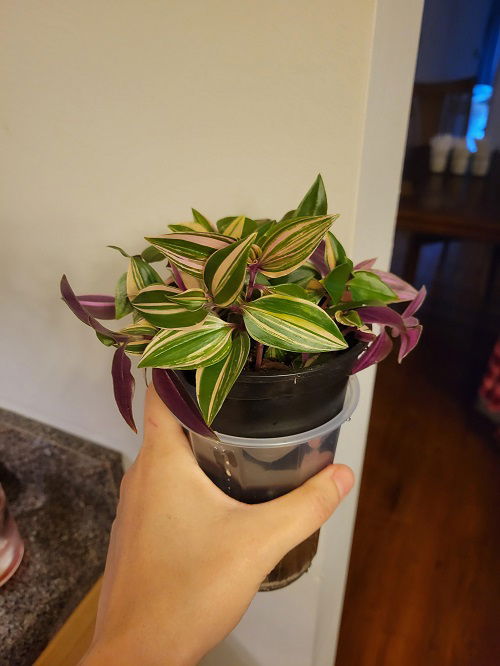
Maintain optimal moisture levels effortlessly with self-watering pots.
5. Use Stubby Planters
Use a stubby planter for a minimalist look and showcase it anywhere you like.
6. Go For Macramé Hangers
Macramé hangers allow the vines to drape elegantly, providing a boho-chic feel.
7. Hang the Plant from the Ceiling
Secure ceiling hooks to dangle the plant pots at various heights.
Check out the best wandering jew varieties here
8. hang the plant near a window.
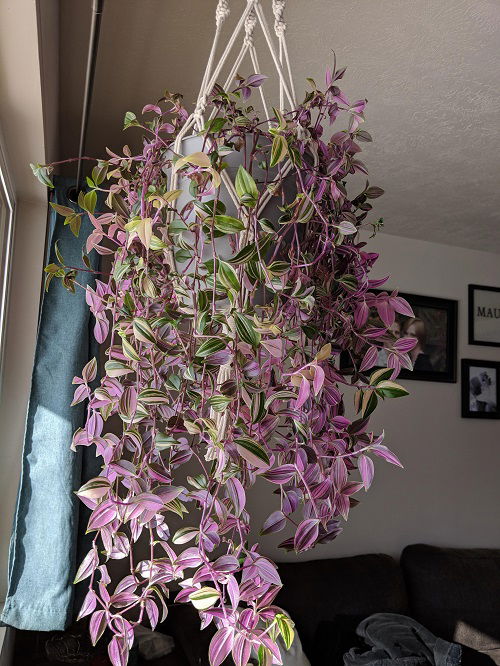
Utilize window mounts to let the plant receive maximum sunlight.
9. Go For Tiered Hanging Pots
Multiple-tier baskets allow you to hang more than one plant, creating a lush appearance.
10. Hang the Pot on a Hook
Hang the plant over doors using special hooks for an unexpected display.
11. Keep it On Floating Shelves
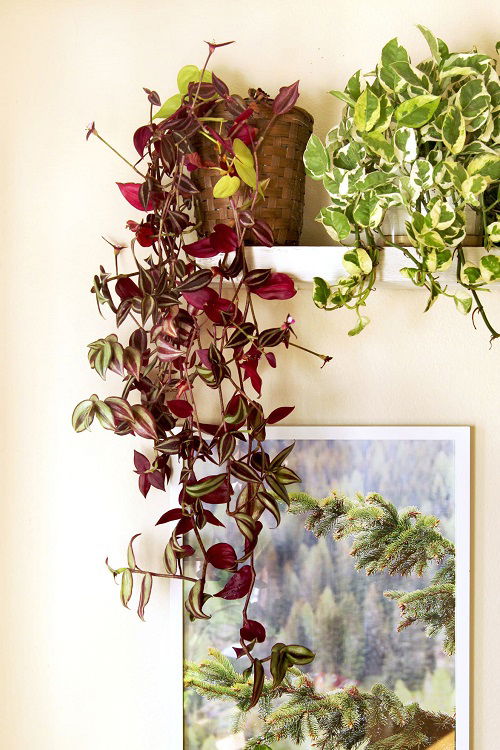
Place the plant on floating shelves along the wall, allowing the vines to trail down.
Wandering Jew Care | How to Grow an Inch Plant Indoors
12. keep its pot on a bookshelf.

Integrate the plant into a bookshelf for a burst of natural color among your books.
13. As a Coffee Table Centerpiece
Make the plant as centerpiece of your coffee table for a vibrant focus point.
14. Keep it Near a Table on a Tall Stool
Set the plant on a tall stool near a side table next to your sofa or bed for easy admiration.
15. Hang it on a Shower
Brighten up your bathroom by placing the plant on the shower or keep it in a corner.
16. Display it in Quirky Containers
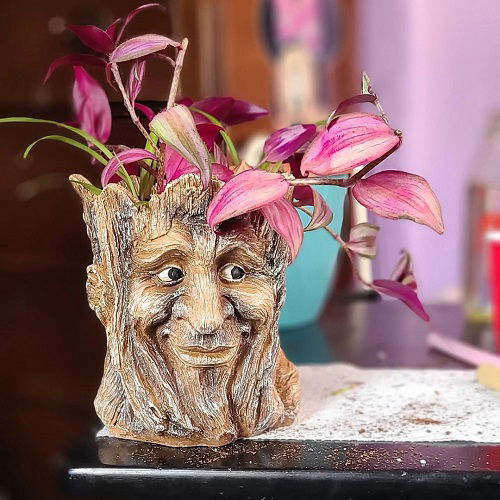
Use face containers or any other quirky pot of your choice to make the plant stand out!
Is Wandering Jew Toxic to Cats & Dogs? Find Out !
17. keep the plant on a tall chair and let it ‘flow’ down.
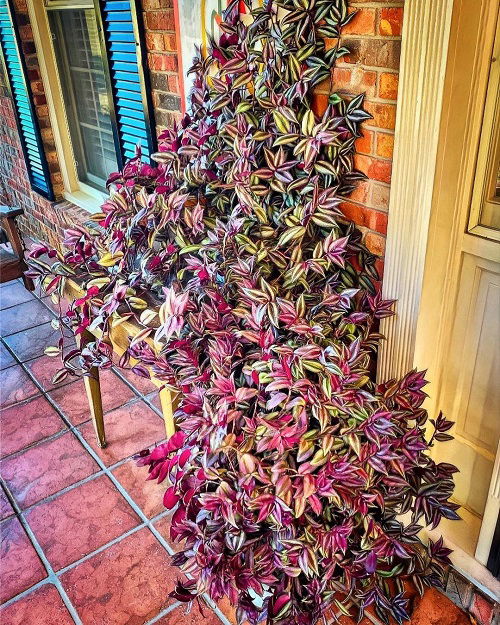
A tall chair in the living room or in patio is a super cool way to showcase its dangling stems and foliage!
18. Grow it in a Window Box
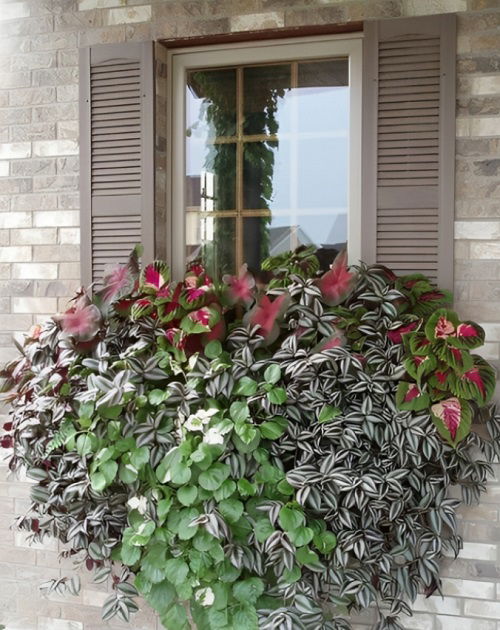
The colorful and trailing leaves of the plant will add to curb appeal of the home when you grow it in a window box .
19. Grow it in Water
A clear vase filled with water will make the pretty foliage of this plant take center stage. We have a great article on it here .
20. Hydroponic Jar
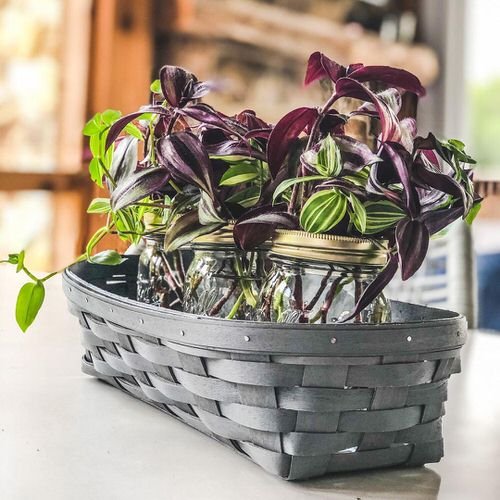
You can easily find hydroponic jars online; if you don’t, do make one yourself .
21. Test Tubes
You can also grow individual Wandering Jew cuttings in test tubes.
22. DIY Mannequin Planter
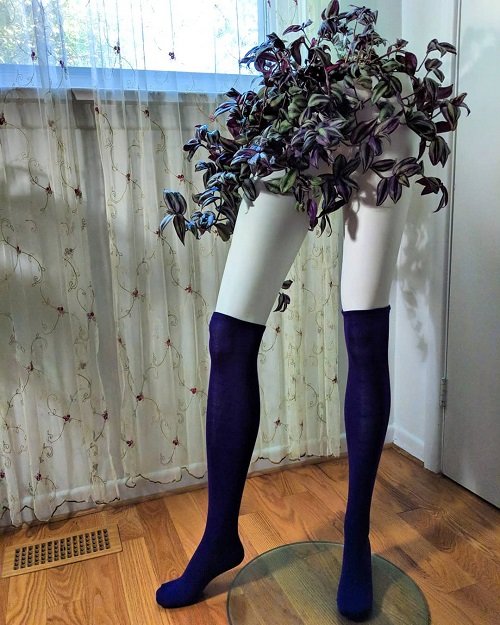
The idea isn’t to copy this one but to find a quirky thing in your home and upcycle it.
23. Hang Them Outside

The bright light will surely make the colors pop. What you’re seeing is Tradescantia Nanouk and Tradescantia Zebrina.
24. Make a Natural Curtain
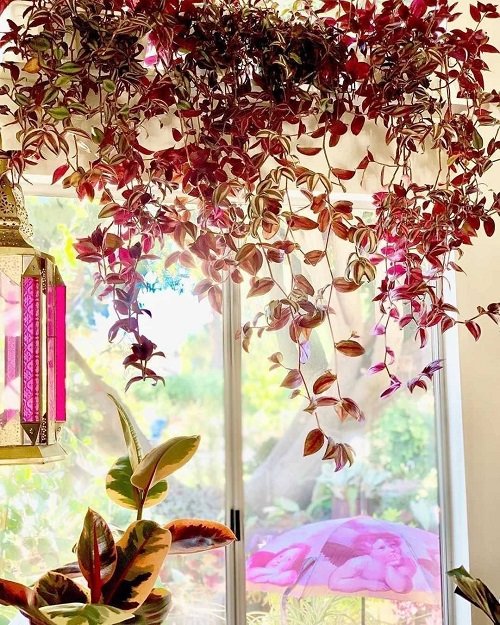
What better way to adorn the windows than this natural plant curtain? We found the idea here .
25. Mini Wandering Jew Tree
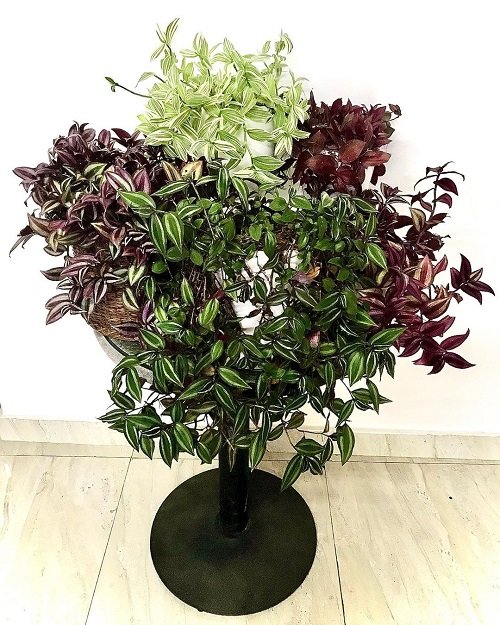
Get a plant stand and pair up different wandering jew varieties for a colorful tree display.
26. Hang it on the Window

If your plant has grown a bit, you can hang it near a window. A northeast window would be perfect.
27. Create a Colorful Shelf Display
The vines trailing down and reaching the ceiling at the same time will create a stunning display.
28. A Cutting Trio
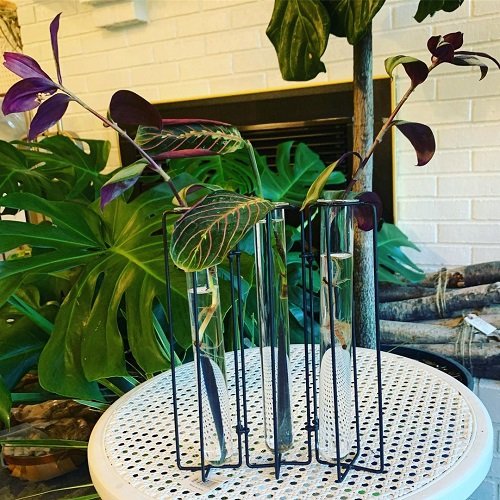
Test tubes are great at another thing – growing wandering jew cuttings.
29. Grow it in a Railing Hanger
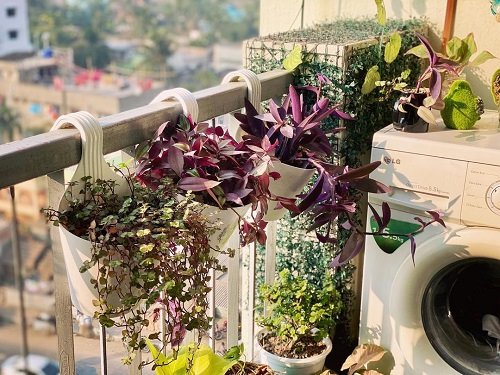
What a great idea to save space! Don’t forget to pair it up. What you’re seeing is Turtle Vine , Wandering Jew, and Purple Heart .
30. Keep it on the Top Shelf
Keep the pot on the top shelf. In time, it will create a dense, trailing display.
31. Root it in a Test Tube
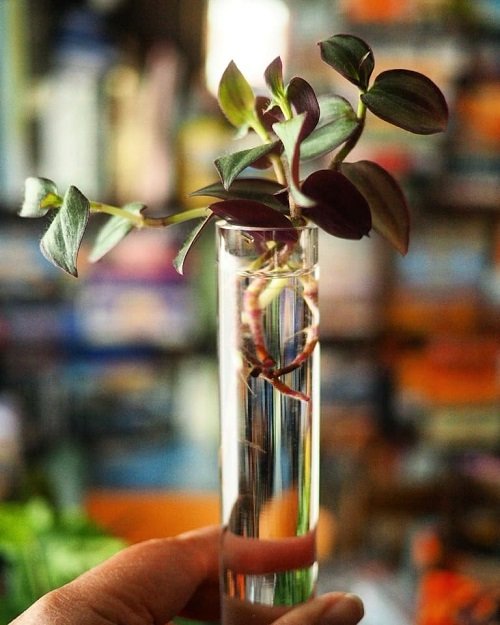
Test tubes are great for rooting these plants and help keep track of growth.
32. Near a South Facing Window
SaltMill grew this one in a wide planter near a south-facing window , and here’s the result.
Recent Posts
18 purple spring flowers, 32 best long lasting flowers for yard and garden, 10 drought tolerant vines for a worry free garden, 8 herbs with blue flowers, 7 super tips on how to revive hydrangeas again, this banana peel water can boost plant growth quickly, grow marigold from cuttings to propagate more plants quickly, 8 climbing green vegetables that are vines, join our 3 million followers:, related articles, how to grow cilantro indoors easily, how to propagate an elephant ear plant: 4 best ways, how to grow dischidia nummularia easily, 26 indoor plants you can grow in glass containers, 21 fabulous indoor plant decor ideas— for every part of home, 22 houseplants that grow best from division, leave a reply cancel reply.
Save my name, email, and website in this browser for the next time I comment.

Get the Best of BalconyGardenWeb Directly in your inbox.
POPULAR CATEGORY
- Best and Top of Gardening 1566
- Flowers & Blooms 620
- Growing Houseplants 599
- Gardening Guide 413
- Gardening Ideas 380
© 2023 Balcony Garden Web | All rights reserved
- Privacy Policy
- Terms of Service
- Feedback Page
- Air Conditioning
- Easter Eggs
- Tablescapes
- Pillows & Throws
- Doors & Windows
- Raised Garden Beds
- Centerpieces
- Party Decor
In-depth Guides
Product reviews, rooms & spaces, living room.
- Fireplaces & Mantels
- Walkways & Paths
- Pools & Ponds
- Kitchen & Dining
- Laundry Room
- Home Office
- Windows & Doors
- Floors & Ceilings
- Ask DIY Question
- + Post Project
- + Post a new Project
- Saved Projects
- Notifications
- Account Settings
- Support • Privacy
- DIY Projects
I have this growing in different parts of my garden. Is it a weed?

I consider it a WEED! I have tried for over 40 years to get it out of my flower gardens and still have not won the battle!! I wish I knew what I could spray it with or something to kill it..it is growing everywhere!!
Related Discussions
Gnats - how to get rid of them.
Somehow my house and garden got tiny gnats that killed my fuchsia plant and fly everywhere. I have tried ALL the Web recommendations - soap and oil dishes, sand in th... See more
Marigolds growing! Should I pinch the buds?
My marigold plants are growing. I heard that pinching the buds until Autumn will allow them to grow without killing the plant. Is this true?

What's the best flower/plant to grow in Texas?
I know that opinions vary, but what's your opinion?!I have great luck w Rosemary plants. Green all year long.
How to care for a dogwood tree?
How to get rid of termites?
Suggestions on how to get rid of termites naturally are appreciated however if there is only a chemical solution for these pests please share as well. Thank you!
Can I grow pumpkins verically? In my community garden plot?
Pumpkin takes up alot of room in my small community garden plot. What can I use that is no more than 5 feet high to vertically plant pumpkins, or, watermelon or squa... See more
I have planted several perennials in my garden year after year! Help!
My perennials never come back for a second year, and it's getting really expensive to buy perennials that last only one year.
Suggested Project Book
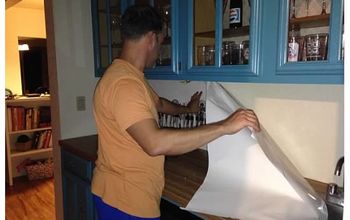
13 Incredible Kitchen Backsplash Ideas That Aren't Tile

IMAGES
VIDEO
COMMENTS
The thick green leaves have a fuzzy texture and a purple hue on the underside. You can easily propagate it from the cuttings, both in soil and water, once it gets growing. It bears delightful clusters of blue, purple, white, or rose pink flowers, making it one of the best types of wandering jew plants on the list. 5. Tradescantia Sillamontana.
The wandering Jew plant is a common name for different species of plants that belong to the Tradescantia genus. There are around 75 different types of plants in Tradescantia genus and some are called inch plants, spiderwort, striped wandering Jew, Boat Lily, Purple Queen, or flowering inch plant. Wandering Jew plants are great house plants because they are relatively easy to care for.
Repotting Tradescantia Plants. If your wandering jew is beginning to become a bit crammed in its pot, select a pot that's 1-2″ wider than its current one. Prepare your pot with a little fresh potting soil around the sides. Remove your inch plant from its existing pot, setting the root ball into the new one.
Fill a 6-inch to 1-gallon container that drains with a rich, well-drained potting mix. Water the soil to settle it. Make about a 2-inch indentation in the soil where you want to place the Wandering Jew cutting. Remove the bottom leaves from the cutting where you will be inserting it into the soil.
Formerly known as the Wandering Jew, this plant's name has evolved due to its controversial nature, with "Wandering Dude" emerging as an alternative. This plant has a rich history and a variety of uses that make it a favorite among gardeners and indoor plant enthusiasts. Tradescantia zebrina - Wandering Dude: An In-depth Look
Wandering Jew plants should be watered regularly to maintain a balanced moisture level in the soil. However, the soil should not be allowed to become too dry or too wet. Overwatering can lead to root rot. A good way to check if it's time to water is to push your finger about 1-inch into the soil.
W andering Jew Plant Care. To keep your Wandering Jew plant thriving, ensure it receives bright, indirect sunlight. Keep it in average room temperatures of 60-75°F (16-24°C). Fertilize once a month during spring and summer. In winter, relocate the plant to a cooler area with temperatures of 54-59°F (12-15°C).
To care for a Wandering Jew plant indoors, place it in a location with bright, indirect sunlight, such as near a window. Water it when the top inch of soil feels dry, typically every 1-2 weeks, and provide well-draining soil. Additionally, mist the plant occasionally to increase humidity and remove dust from the leaves.
Propagating wandering jew in soil is easy. To do this, start by taking multiple cuttings at the ends of branches, cutting at a 45-degree angle slightly beneath a leaf node using a clean, sharp blade. The length of the cuts should be between four and six inches. Remove the lowest set of leaves from each cutting's stem.
Tradescantia zebrina (commonly known as wandering Jew, spiderwort, or inch plant) is popular for a reason: This beginner-friendly houseplant is low-maintenance and grows quickly. ... The leaf undersides are deep purple in color and the tiny, three-petaled flowers are bright pink. Although this species is naturally a creeping plant, it's often ...
Growing tradescantia (also known as spiderwort) might cause flashbacks to the 1970s but it still merits its popularity as a houseplant or a groundcover. This tough tropical plant can have trailing or upright stems and colorful foliage.Depending on the species, tradescantias are typically purple and often variegated with silvers, greens, creams, even pinks, and occasionally gold.
The blue flowers appear over the warmer months and ... As well as scurvy weed, alternative common names include (native) wandering Jew, forget-me-not, and creeping Christian. Description. Commelina cyanea ... (1-3 in) long by 0.5-1.5 cm (0.20-0.59 in) wide. The flowers can occur at any time from spring to autumn. They are deep blue and ...
Wandering Jew can grow 6 to 9 inches tall and spread 12 to 24 inches. It grows quickly. So quickly that when grown in the soil as a groundcover, it spreads aggressively and has been classed as an invasive species in South Africa and the Galapagos Islands. Another good reason to grow this plant in a pot! The flowers are small and have three petals.
Tradescantia ( / ˌtrædəˈskæntiə / [4]) is a genus of 85 species [5] of herbaceous perennial wildflowers in the family Commelinaceae, native to the Americas from southern Canada to northern Argentina, including the West Indies. Members of the genus are known by many common names, including inchplant, wandering jew, spiderwort, [6 ...
Tradescantia zebrina. trad-es-KAN-tee-ah zeb-REE-nah. This trailing perennial is grown for its foliage. Fleshy leaves have two silvery stripes and purple undersides. Flowers bloom intermittently throughout the year. Wandering Jew, a common houseplant, is native to Southern Mexico. Care Provide full sun or part shade and moist, fertile soil.
Wandering Jew or the Inch plant can be credited for starting the whole trend of plant swapping. Years before indoor plant gardening became a profitable business, friends, family, and fellow plant parents swapped cuttings of the wandering jew. The Wandering Jew is native to tropical and temperate climates and grows vigorously with very little care.
Commelina benghalensis, commonly known as the Benghal dayflower, tropical spiderwort, or wandering Jew, kanshira in Bengali, is a perennial herb native to tropical Asia and Africa.It has been widely introduced to areas outside its native range, including to the neotropics, Hawaii, the West Indies and to both coasts of North America. It has a long flowering period, from spring to fall in ...
Wandering jew plants are super easy to propagate. Take cuttings that are 3-4″ long, and include a couple of leaf nodes. Dip the cut ends into rooting hormone, then stick them in moist soil. Don't allow the soil to dry out, and keep the air around the cuttings humid. A propagation chamber makes this simple.
Common Name: Wandering Jew. Species Name: Tradescantia zebrina. ... Examples of Wandering Jew Tradescantia zebrina. A purplish green Wandering Jew leaf. A bright purple Wandering Jew flower. A Wandering Jew plant growing in a pot. Plant Facts ; Origin: Mexico: Sun Preference: Partial: Susceptibility: Pinch regularly to keep plant bushy and ...
Different Ways to Grow Tradescantia Indoors. 1. Keep it On Plant Stands. Opt for a plant stand where you can keep the plant in a pot to make it like a colorful and small room centerpiece. 2. Try DIY Planters. Use DIY planters to give the plant a more personalized appearance. 3. Do Not Miss Basket Planters.
Wandering trad is a ground cover succulent. Stems are soft and easily broken. The fleshy stems root at any node that is on the surface. Leaves are oval dark green, and shiny 5-10 mm long, leaf blades 3-6.5 cm long, 1-3 cm wide, with parallel veins covered with small hairs. Flowers are small white and three-petalled flowers with yellow ...
Wandering Jew House Plant in 1-in Pot. ... Its trumpet-shaped, periwinkle blue flowers are fragrant and bloom throughout the Summer and into fall. It has a compact, mounding habit and is densely branched. Once established, it is also drought tolerant. Like other catmints, it releases a fragrance that attracts cats when the stems are broken. ...
Anne stickn354ey on Jul 16, 2015. weed is a matter of opinion- it does grow wild, and it can take over a lot of territory. Somewhat like a wandering Jew plant. The blue flowers are a pretty color, tho. Connie Hoge on Jul 16, 2015. Commelina communis, commonly known as the Asiatic dayflower. Paula Swasko on Jul 16, 2015.